Taste, texture and health: it’s not just for humans


At DSM Food & Beverage we understand that meeting the evolving needs of pets and their parents isn’t an easy job. That’s why we offer a unique portfolio of ingredients, solutions and expertise supported by 60 years experience –all aimed at creating delicious, nutritious and sustainable dog and cat food.

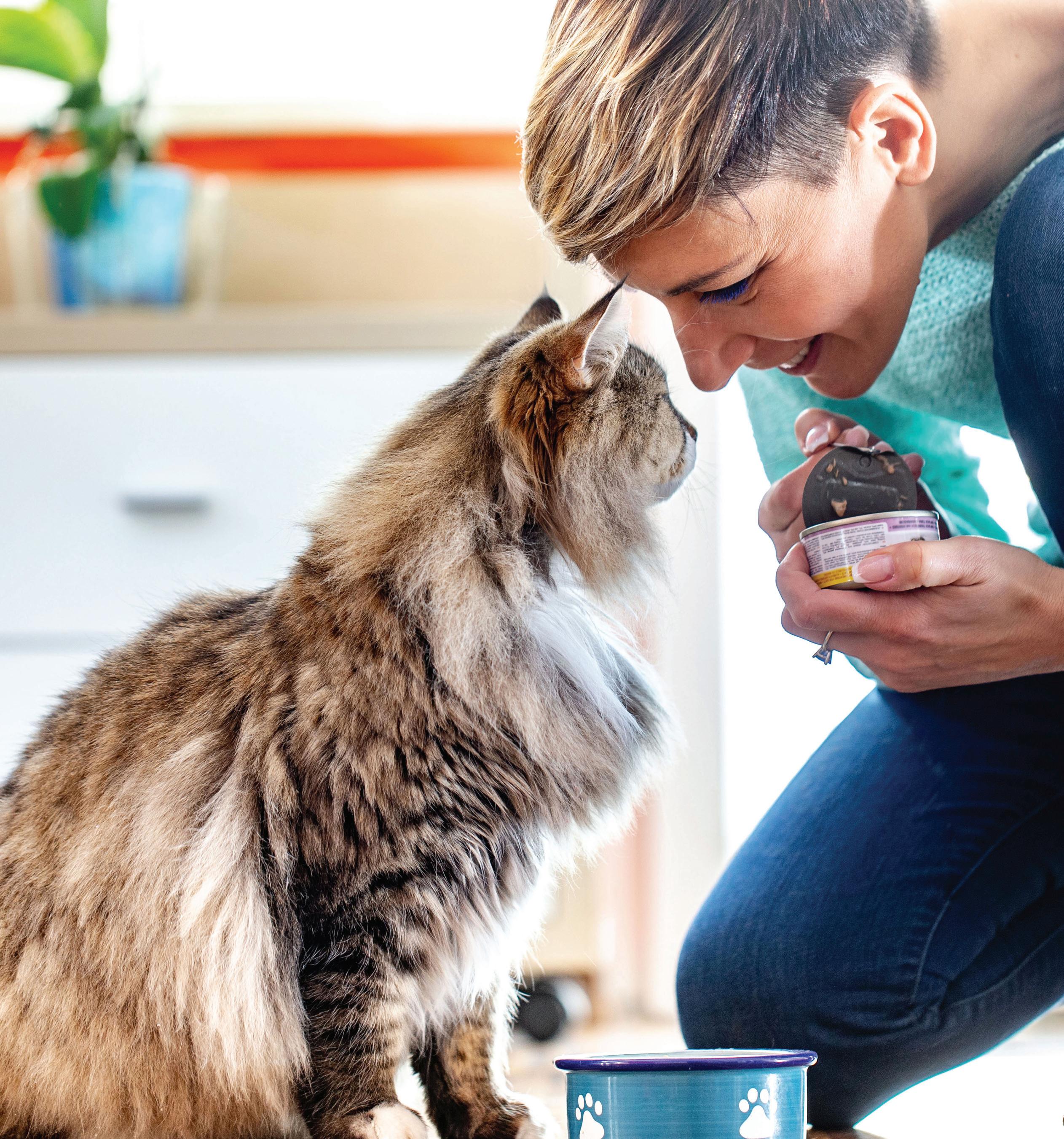






From on-trend fortification that boosts health; to sensory solutions that improve taste and texture; to microbiome modulation that goes ‘beyond the gut’, we’ll work with you to create differentiated products that pets and pet parents everywhere will love. Enjoy it all.

NUTRITION •
• SUSTAINABLE
HEALTH
LIVING

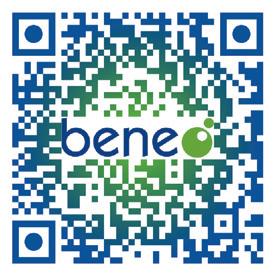
www.beneo.com Follow us on: Matching today’s expectations. Natural ingredients for healthy animals. BENEO-Animal Nutrition is specialized in providing feed ingredients from natural sources that allow real product innovation in order to meet today’s expectations. proteins help to improve the well-being of all kinds of animals.
find out more visit: www.beneo.com/ingredients/animal-nutrition
To
Subscription rates: Pet Food Supplement is distributed free of charge, to individuals based in Europe and involved in the pet food sector who have registered to receive a copy. To register to receive future issues, please visit www.pentlandspublishing.com/pfs.









Pet Food SuPPlement 2023 Page 1 Pets in Society 2 By Ryan Mounsey How European Pet Food Brands can Capitalise on the China Market Opportunity 6 By Mim Figueiredo The Mirror of Our Pets’ Inner Health 8 By Sarah-Jane Godfrey What’s in a Name? Food for Pets or Animal Feed, a Paradox for Ensuring Pet Food Safety? 13 By David Primrose The Natural Way to Support a Pet’s Gut Health 16 With Dr Maygane Ronsmans SmartMoisture: Improving Sustainability in Pet Food Production 18 By Victoria Thornber The Invisible Link Between Nutrition and Mental Health 20 By Dr. Robert Falconer-Taylor and Francesca Susca The Unrivalled Benefit of Betaine in Pet Food 24 By Pauline Rovers-Paap Pet Food Safety and Freshness Concerns: Origins and Consequences 28 By Cristina Murcia García, Elena Fraccaroli and Bartosz Lebida Challenges and Trends in the Booming Pet Food Industry 34 With BESTMIX Software A Proactive, Customised Approach to Pet Care By James Kyffin 36 Natural and Cost-Effective Antioxidants Solutions By Yohann Hureau 38 Pet Subjects 39 Contents 2023 Vol. 25
htm#register ISSN 0950-771X Views expressed by contributors are not necessarily
of the
© Feed Compounder 2023 Editorial assistant: Andrew Mounsey Advertisement/Sales Manager: Fiona Mounsey Editor: Ryan Mounsey Published by: Pentlands Publishing Ltd Plas Y Coed Velfrey Road Whitland SA34 0RA United Kingdom Tel: +44 (0) 1994 240002 Web site: www.petfoodsupplement.co.uk E-mail: mail@feedcompounder.com
those
Publisher.
Pets in Society
By Ryan Mounsey
Pet Populations - 2023
U K Pet Food (previously known as the Pet Food Manufacturers’ Association) recently released its UK pet population data for 2023. As has been the case since 2021, with the onset of the pandemic, the survey was conducted online rather than face to face. It is, therefore, not possible to draw robust conclusions from comparisons of the current figures with those compiled before this change in methodology.
Industry Outlook
Globally, the value of the pet food market increased by $5.57 billion in 2022 to $72.02 billion in 2023, a rise of 8.4 per cent, according to Alltech’s Agri-Food Outlook 2023. The US remained the largest region in the pet food market. However, China displaced Western Europe as the second largest player in the sector for the first time - more on this on page 6. Western Europe became the third biggest constituent. The global pet food market is predicted to continue strongly and is expected to grow to $94.97 billion by 2027 with a compound annual growth rate of 7.2 per cent.

The total pet population for 2023 had increased by 3 million or 9 per cent from a year previously to 38 million. However, the percentage of households owning pets fell from 17.4 million in 2022 to 16.2 million currently, a 7 per cent decrease.
Populations of both dogs and cats had decreased from year earlier levels with the former falling 7.5 per cent to approximately 12 million and the latter by 8.0 per cent to approximately 11 million. Numbers of indoor birds also dropped from a year earlier and did so by a fairly considerable number, down almost 20 per cent to 1.3 million. In contrast, there has been a 50% rise in the number of smaller pets such as rabbits, guinea pigs and hamsters recorded in the results of the 2023 survey, with small pet population increasing by 1.7 million up to 5 million in total.
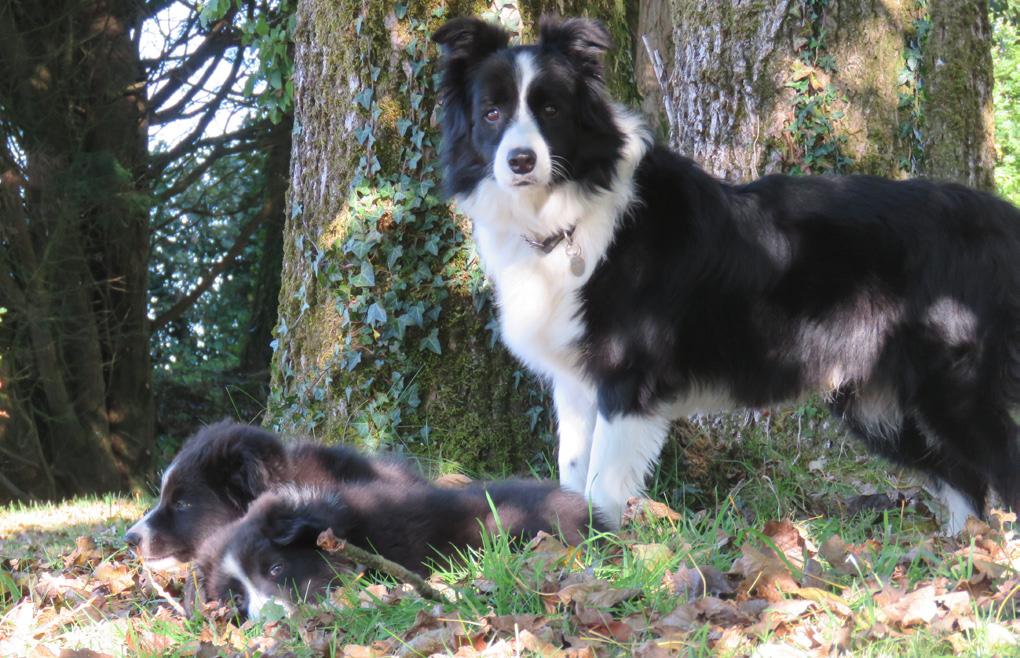
Overall, 57 per cent of UK residents own at least one pet. Canines remained the UK’s most popular pet, with 31 per cent of households surveyed possessing a dog. Cats were relatively close second, with 26 per cent of Brits owning (or being owned by) felines. 15 per cent of us were home to some level of indoor fish keeping and a further 11 per cent of households kept fish outdoors. As a result of the increase in small pet ownership: rabbits were now present in 2.8 per cent of households, up from 2.4 per cent in 2022; 2.1 per cent of people kept hamsters, up from 1.5 per cent last year; and guinea pigs were now living with 1.8 per cent of the population, rising from 1.3 per cent a year previously.
The report re-iterated the strength of the pet food industry, reporting a global increase in pet food production of 7.25 per cent from 2021 to 2022, up 2.4 million tonnes to 32.9 million tonnes. Europe was the second largest producer of pet food behind North America and had increased its output by 0.2 million tonnes or 1.65 per cent from 2021 levels to 11.8 million tonnes in 2022. North American pet food production had risen from its 2021 output by 0.6 million tonnes or 5.66 per cent to 11.2 million tonnes. The Asia-Pacific region also experienced significant growth from 2021 levels of 9.33 per cent or 0.2 million tonnes, however, the total pet food production in this region amounted to just 2.5 million tonnes. This highlights the region’s continued reliance on the importation of pet feed and a number of potential opportunities for European pet food producers looking to expand into this growing market.
From Crisis to Crisis
The well-documented rise in pet ownership rates brought about due to lockdown, along with some fairly self-evident problems as to what would happen when it came time for these new pet owners to return to work from the office as opposed to from the comfort of their homes,
Page 2 Pet Food SuPPlement 2023

+44 (0)2890 755566 smartmoisture.com ↘ A patented moisture management technology Key benefits Maximises production output Reduces energy costs and enhances profit margins Increases food safety
coupled with the advent of the cost of living crisis, has unfortunately, created the perfect storm for pet relinquishments.
UK Pet Food estimates that the number of households that have relinquished a pet stands at 3.7 million or 13 per cent; this figure rises to 28 per cent among owners aged 16-24 years old. On a species by species basis, 47 per cent of previously pet-owning households gave up a dog, 3 per cent relinquished a cat, 12 per cent an indoor bird, 8 per cent a rabbit, 6 per cent a guinea pig and 7 per cent another pet.
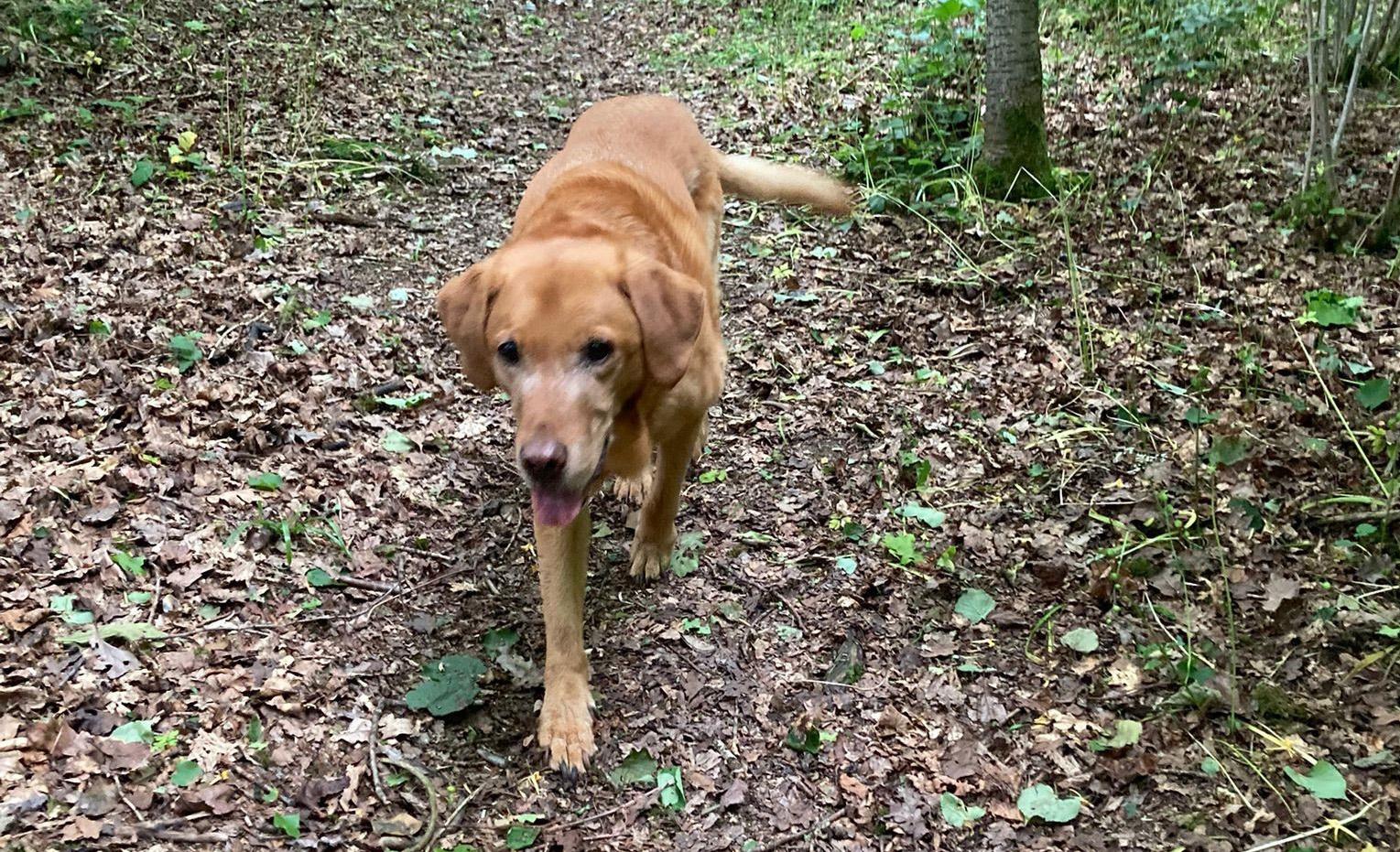

Startlingly, UK Pet Food learned that only 29 per cent of pet owners considered the cost of owning a pet before committing to take care of them, with 18 per cent of owners surveyed admitting that this cost was more than they expected. In addition, 30 per cent of those aged 16-40 had confessed that the cost of living crisis had made them reconsider pet ownership.
Whilst the majority of rehoming was seen from the households of larger pets, the current increase in small pet ownership has raised concerns about the future welfare of these animals too. Nicole Paley of UK Pet Food commented: “World events have had a massive impact on lifestyles over the last few years. Throughout the pandemic, we saw an increase in people adding a pet to their family as they sought the amazing companionship a pet can bring. Today, owners are clearly impacted by the cost of living and sadly relinquishment figures are high. The small pet population is on the up suggesting that people believe they are more manageable and less expensive to keep. Although pets bring huge joy to a household, they also come with a huge responsibility and it is so important to understand the care and cost implications –whatever the size of your pet.”
for rabbits over the past two years. Although they’re smaller in size, it doesn’t mean they’re smaller in cost or responsibility, so we encourage careful consideration before taking on a pet of any species.”
Beyond the relinquishment of pets, there were further impacts caused by the rise in financial pressures that pet owners have found themselves subject to. 20 per cent of pet owners have confirmed that they have had to make cut-backs on one or more aspects of their pet’s care, whether that is on insurance, vets’ visits or pet food itself.
This is echoed by Natalie Powdrill-Wells, Research Officer at Woodgreen Pets Charity who stated: “We are now experiencing a deluge of demand on our services, with long lists of pets waiting to come into our care as owners can sadly no longer look after them. As a charity, we’re definitely feeling the impact of an increased small pet population in the UK – with a 250% increase in relinquishment requests
However, the huge benefits of pet ownership, especially in times of crisis, should not be overlooked. It has been shown on numerous occasions that companion animals can alleviate feelings of stress, anxiety and depression and owners even need fewer trips to the doctors. 50 per cent of those surveyed by UK Pet Food reported that pet ownership aided their mental well-being and this rose to 60 per cent in older respondents.
Pet relinquishment is a last resort for owners in times of crisis but there is an increasing level of help for those struggling to take care of their beloved companion animals. An alliance of pet food producers, pet stores and insurers have teamed up with UK Pet Food and charity FareShare to provide over 304,000 meals to hungry pets across the UK through FareShare’s network of 9,500 charities and food banks. The UK Pet Food website also contains a wealth of information for pet owners looking to minimise expenditure on their companion animals whilst ensuring they receive the best possible care, including fact sheets on ‘How to Feed Your Pet on a Budget”.
Health Over Headlines
A recently published study in the Journal of Animal Science has reportedly found that Vegan diets are healthy for dogs. Admittedly, these claims are made by the media who have picked up the study whereas the study itself merely stated that “…the mildly cooked human-grade vegan diets tested in this study performed well.”
This, at the very least, highlights that the problematic sensationalisation of dietary trends extends beyond human nutrition into pet nutrition and that companion animal owners should be increasingly mindful of where they source the information with which to decide their pets’ diets.
Additionally, how can a study that ran for just three weeks, comparing “ two mildly cooked human-grade vegan diets” against a
Page 4 Pet Food SuPPlement 2023
“chicken based extruded dog diet” in only 12 dogs of a single breed possibly determine on the suitability of a diet as broad as veganism for an entire species? Surely longer term and more extensive studies are needed before this is even tentatively speculated.
The headline results of the study were that stool composition and quantity were similar to that of the control diet and that certain blood triglycerides and cholesterol were significantly lower in the dogs fed vegan diets. It appears here that we have ventured beyond just the humanisation of pet food branding to the humanisation of health markers too.
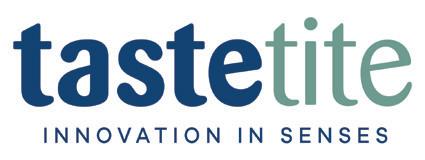
Dr. Caroline Jochman, a veterinarian with WVRC Emergency & Specialty Pet Care states that: “Cholesterol does not have the same effect on their [canines’] heart, and their digestive systems are designed to accommodate animal fat”. As such, lower blood cholesterol levels can hardly be viewed as a beneficial impact of vegan diets in dogs and it could perhaps be argued that it is a negative. Furthermore, dogs do not have the same issues with colon cancer as humans do says Dr. Joseph Wakshlag, veterinary nutritionist at Cornell University College of Veterinary Medicine in Ithaca, New York. “So the idea that eating foods high in soluble fibre or low in saturated or trans-fats will provide any health benefit is really unknown at this point.”
Studies also show that there is very little to no salivary amylase present in canine saliva1 and their jaws are incapable of the ‘side to side’ chewing associated with the grinding of food, hampering their ability to process large amounts of plant based material.

Plant based diets are becoming increasingly popular amongst humans whether that be for health or ethical reasons and is down to individual choice. The same cannot be said for pets fed plant based diets, where food choices are made for them, in which case ensuring the
pets’ health has to be the priority of any owner above all else. So until more extensive, longer term studies are done on the impact of veganism in dogs it would perhaps be wise to follow millennia upon millennia of evolution and continue to include meat in canine diets.

References
1 The Saliva Proteome of Dogs: Variations Within and Between Breeds and Between Species (2018): https://doi.org/10.1002/ pmic.201700293

Pet Food SuPPlement 2023 Page 5
How European pet food brands can capitalise on the China market opportunity
 By Mim Figueiredo, International Business Development Europe at Tmall Global, Alibaba Group
By Mim Figueiredo, International Business Development Europe at Tmall Global, Alibaba Group
China is now the second-largest market for pet food in the world after the United States, despite having roughly half of the US’ pet ownership rate and is continuing to grow at pace1
Between 2016-2021, the market tripled in value, with an even split between dog and cat-related products. A sign of the booming market, consumers using Alibaba’s platform Tmall Global, an online and mobile commerce platform, can browse more than 2,000 unique products in the pet food category, up from just 138 in 2016.
The pet food market’s rapid growth can be attributed to two factors. First, increased pet ownership and second, higher spending per pet. Both are likely linked to China’s underlying demographic trends.
According to Bain & Company, 45% of new pet owners in China were born in the 1990s and 35% in the 1980s. Millennials and Gen Z
Speciality Ingredients for Pet Foods


view pets in a fundamentally different way to preceding generations – for them, pets play an important emotional role as extended family members rather than functional roles, such as guard dogs.
This attitude shift has resulted in surging demand among Chinese consumers for a diverse array of pet products, from premium nutrition, health supplements and oral care products to grooming, fashion accessories and toys. The trend of “buying better” for pets was one that was particularly prominent during Alibaba’s 11.11 Global Shopping Festival in 2022, with high growth in imported pet food and innovative product categories, such as freeze-dried cat food, wet cat food and super premium dog food for small and mediumsized dogs.
Despite the rapid growth of the pet food market in China over the past five years, it is still in its nascency. Both pet ownership and spending levels per pet are expected to continue to increase, with China’s pet food expected to nearly double from 2021 to by 2025.
To put this into perspective, other FMCG categories where international brands have flourished through cross-border eCommerce in China over the past 10 years include skincare & cosmetics and maternity & baby care, with their market sizes reaching $60bn and $100bn respectively and comprising of approximately 10 times more brands than the pet care category. China’s pet care brands, meanwhile, are still in the early stages of growth and there remains potential for a $1bn brand to emerge.
The size of the opportunity presented by the Chinese market is likely not a surprise to most brands – the challenge is how to capture it. While the pet food segment is heavily regulated by Chinese import authorities, there are still possibilities for overseas suppliers. Working with cross-border channels like Tmall Global, brands can explore how to win over Chinese consumers, manage cross-border supply chains and navigate one of the most complex online and offline channel landscapes in the world.
References
1 Bain & Company/Tmall report (2021): https://www.bain.cn/ pdfs/202210080602046522.pdf
Page 6 Pet Food SuPPlement 2023
Inovitec Ltd Unit 5A, Tarporley Business Centre, Nantwich Road, Tarporley, Cheshire, CW6 9UT. E: info@inovitec.co.uk T:+44 (0)1829 730407


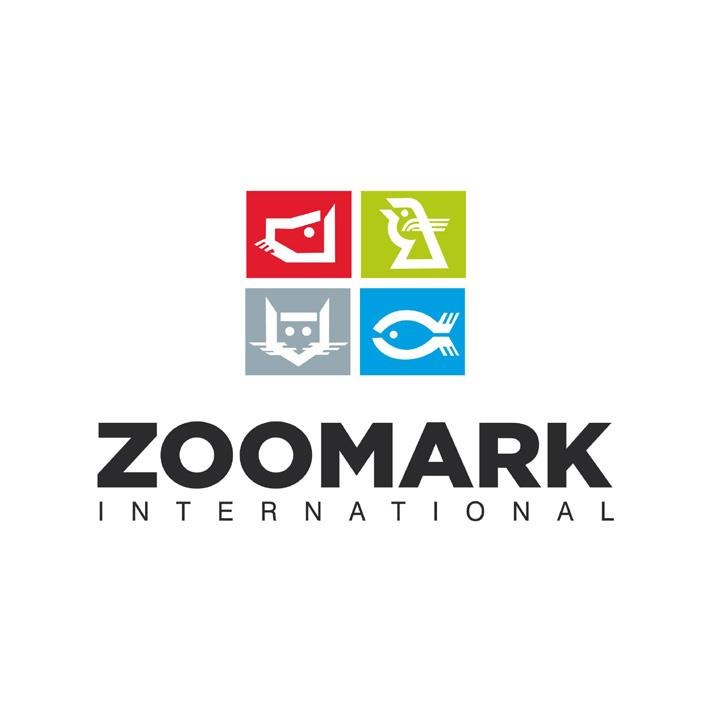
The Mirror of Our Pets’ Inner Health
 By Sarah-Jane Godfrey, Pet Technical Manager, Trouw Nutrition GB
By Sarah-Jane Godfrey, Pet Technical Manager, Trouw Nutrition GB
Health of the Skin and Coat
There is nothing better than another person complimenting us on our companion animals’ good looks. Supple, smooth skin, healthy paw pads, strong nails and a dander free, glossy coat are some of the key visual signs we look for when evaluating our pets’ health. In a UK survey, out of 3,707 small animal consultations in general practice, 795 (21.4 per cent) involved animals that had a dermatological problem (Hill et al, 2006). Optimising skin health is certainly therefore a concern for vets and pet parents alike.
As a result of this, the impact of nutritional intervention on skin and hair condition has been a key area of companion animal research. In addition, our expanding knowledge of gut health has also revealed the influence of the microbiome and its metabolites on remote organ health, including the skin. This link is described as the gut-skin axis and is an emerging area of research (Pilla and Suchodolski, 2021).
Dog and Cat Skin Function and Structure Function
The skin is a vital organ and is part of the integument, which includes hair, claws, paw pads and some glands. It is considered the largest organ of the body and has a complex structure. The integument provides many vital functions which are described below (Garland, 2013; Aspinall and Cappello, 2015; Morellio, (2022): Lawton, (2019).
1. pain, pressure and touch.
Sensation - sensory receptors in the skin detect temperature,
They only have sweat glands on the paw pads and nose. Most heat is lost by panting. Cats will also lick themselves. Excretion - glands produce sebum (specialised lipids) which
4. waterproofs and lubricates the skin, and also has antiseptic properties. The cat and dog have sweat glands on the footpads and nose only. Pheromones are also excreted.
Vitamin D synthesis - In the majority of animals UV light
5. conversion of 7-dehydrocholesterol in the skin provides adequate vitamin D. This conversion is limited in dogs and cats, meaning a dietary supply is essential.
6. electrolytes, water, carbohydrates, and proteins.
Storage - Subcutaneous tissues provide storage of fat,
7. immunologically active barrier against pathogens.
Immune function - the skin provides a physical and
Communication - pheromones, secretions from the circumanal
8. glands and glands of the anal sacs. Visual communication (dog or cat raises its hackles when threatened).
2. from environmental trauma such as extreme temperature or chemicals and against infection by microorganisms. Thickened regions of skin, for example, the skin of the paw pads, provide added functional protection. Pigmented skin and hair protect the body against ultraviolet (UV) light damage. The skin’s waterresistant properties also prevent the body from dehydrating or from becoming waterlogged.
Protection - the skin protects structures inside the body
Structure
Thermoregulation - Hair and the fat layer under the skin
3. provides insulation, and blood can be diverted from the skin. The skin’s role in heat loss in dogs and cats is however limited.
The skin consists of two layers the epidermis and the dermis. The epidermis of the skin is a constantly renewing squamous epithelium, made of up to 5 layers of distinctively differentiated layers of keratinocytes. The layers are described as the stratum basale, stratum spinosum, stratum granulosum, stratum lucidum (only in thickened foot pads) and the final outer layer known as the stratum corneum, which has a brick wall like structure. The stratum corneum is made up of corneocytes, which are terminally differentiated keratinocytes,
Page 8 Pet Food SuPPlement 2023
the bricks, which are surrounded by lipids, the mortar. The dermis consists of elastic fibres and connective tissue and is attached to the epidermis by projections called papillae. It contains the blood vessels, nerves and sensory nerve endings. Hair follicles, sebaceous glands and sweat glands are also present in the dermis and are formed from epidermal cells. The hypodermis sits underneath the skin and functions as a moveable support (Kiselev, 2007; Hermanson and DeLahunta, 2020; Aspinal and Cappello, 2015).
Melanocytes are located in the stratum basal and are responsible for the production of the hair and skin pigment melanin. Merkel cells in the basal layers of the skin are specialised sensory cells associated with skin sensory organs, eg, whiskers and tylotrich pads. These cells may also influence cutaneous blood flow and sweat production, coordinate keratinocyte proliferation, and stimulate stem cell growth of hair follicles. Langerhans cells located in the stratum spinosum are mononuclear dendritic cells, which regulate the immune system of the skin. Keratinocytes represent around 90% of the cells in the epidermis, melanocytes 5%, Merkel cells 0.5% and Langerhans cells from 2-8% (Henrot et al, 2020, Maibach and Honari, 2014; Jennings and Premanandan, 2017; Moriello, 2022).
The skin is a large and hungry organ!
In the newborn puppy, the skin represents approximately 24% of the total body weight reducing to 12% by 6 months of age (Hermanson and DeLahunta, 2020). It is also constantly renewing itself. Complete renewal of the epidermis takes around 20 days in dogs (Garland, 2013). Due to these facts, the skin has a high nutritional demand. Consequently, issues with skin and coat condition often manifest during nutritionally demanding life stages such as gestation, lactation and growth, or if nutrient absorption is compromised (Roudebush and Schoenherr, 2010) by disease or age, or poor diet.
Optimal intake of key nutrients is therefore required for normal skin cell differentiation, keratinisation, and turnover, in addition to sebum production. Nutrition also affects the antioxidant, immune and inflammatory systems, which can also impact upon the overall health of the skin and consequently the appearance of the cat or dogs’ coat. This review will focus on key nutrients and functional ingredients known to support good skin and coat condition in dogs and cats.
Proteins
A significant proportion of our pet’s daily protein intake is required to support normal skin and hair growth. It is estimated that small dog breeds with long hair utilise up to 30% of their dietary protein intake to maintain hair growth, whereas large, short haired dogs utilise around 10% of their dietary protein intake for this purpose. Inappropriate protein, along with inadequate energy intake is linked to keratinization issues, changes in skin lipids, browning hair colour
or pigmentation issues, alopecia, dry skin and brittle hair (Roudebush and Schoenherr, 2010). There are 4 amino acids required for optimal hair and skin condition.
Phenylalanine and Tyrosine – The colour of the skin and hair of mammals is determined by the type and amount of melanin present. Melanin is composed of two pigment types: eumelanin, which is brown to black, and pheomelanin, which is reddish-brown. Melanin from the follicular melanocytes is secreted into the surrounding keratinocytes where they become incorporated into the hair (Anderson et al, 2002). Both forms are derived from tyrosine which can come directly from the diet, or from the hydroxylation of phenylalanine. Therefore, both amino acids are relevant in terms of dietary intake.
Eumelanin and pheomelanin levels are controlled by activity of the enzyme tyrosinase. Lower levels of activity favour the production of pheomelanin, while higher levels favour eumelanin. What is more, tyrosinase activity is stimulated by tyrosine (Tyr) concentration, with an increase leading to greater production of the blacker pigment eumalanin. In adult healthy Labrador retrievers dogs tyrosine intake of 2.5× the recommended minimum was found to significantly reduce off-black colouration (Watson et al, 2018). For optimal black hair colour in kittens, it was found they require more dietary phenylalanine or tyrosine for optimal melanin deposition than for maximal growth (Watson et al, 2002).
Methionine and Cysteine – Methionine and Cysteine are sulphur containing amino acids. Cysteine is an important constituent of protein secondary structure and thus a major constituent of hair. Methionine is a precursor of cysteine, but methionine requirement cannot be met through the conversion of cysteine. The requirements of both amino acids are considered together, as cysteine can only supply one-third of the total sulphur amino acid requirement. Skin lesions are noted in both dogs and cats fed diets deficient in methionine (NRC, 2006).
Essential Polyunsaturated Fatty Acids
Dogs and cats have specific requirements for key essential polyunsaturated fatty acids in their diet. The omega-6 linoleic acid (LA) is an essential omega-6 fatty acid required by both dogs and cats. The omega-6 fatty acid arachidonic acid is also essential for cats due to

Pet Food SuPPlement 2023 Page 9
their carnivorous evolution which has reduced their ability to synthesize arachidonic acid through biotransformation from linoleic acid via the D-6 desaturase enzyme pathway (Roudebush and Schoenherr, 2010).
Dietary linoleic acid is required in the diet to ensure the epidermal water barrier function of the skin as a component of ceramides which enhance cohesion between the lipid sheets that make up the intracellular lamellae (NRC, 2006) between keratinised cells. Trans epidermal water loss (TEWL) has been observed and a correlation found in dogs suffering from atopic dermatitis (Cornegliani et al, 2012), and to some extent in cats (Szczepanik et al, 2018). In dogs, an omega 6 deficient diet results in the development of scaly skin, dry dull coat and increased trans-epidermal water loss (Lloyd, 1989). Increased levels of dietary omega-6 fatty acids may therefore play a role in supporting skin barrier function (Groves, 2022). AA makes up to 20-25% of the lipid in cell membranes, and along with omega-3 fatty acids, is involved in the formation of eicosanoids, such as prostaglandins and other cell mediators responsible for inflammatory processes (NRC, 2006).
Minerals for the skin Zinc
Zinc is an essential trace element and is required for the function of around 200 enzymes in the body that drive cell replication, protein and carbohydrate metabolism, nucleic acid formation and stabilsation of the structure of DNA, RNA and ribosomes (NRC, 2006). It is needed for normal skin health, wound healing and supports the antioxidant and immune system function. Zinc supports the normal metabolism of essential fatty acids as a cofactor of the enzyme delta-6 desaturase. This catalyses the biosynthesis of linoleic acid into arachidonic acid and is utilised by keratinocytes for the formation of the epidermal layers (Pereira, et al 2021). In dogs, the highest concentrations of zinc are found in the harder wearing, keratinized tissues of the dog’s nose tip, tongue and foot pads (Outerbridge, 2012). Zinc deficiency leads to thinning hair, skin cracking and skin lesions being especially prominent in areas prone to trauma and friction, such as the groin, skin over the joints and the paw pads (Roudebush and Schoenherr, 2010).
Copper
There is no determined requirement for omega-3 fatty acids in adult dogs or cats (FEDIAF 2021), albeit stated by AFFCO. Omega-3 fatty acids, however, have an important role to play in the immune and inflammatory response. Extensive research has demonstrated that supplementation of the omega-3 fatty acids alpha-linolenic acid (ALA), docosahexaenoic acid (DHA) and eicosapentaenoic acid (EPA) are beneficial when it comes to support of optimal skin and hair condition, in addition to total dietary fat content (Bauer, 2007). ALA is the precursor of the long chain fatty acids EPA and DHA however, conversion is limited (Bauer, 2008). It, therefore, makes sense to add these directly to the diet from fish oil or other marine sources such as sustainably produced algal oils, rather than plant sourced ALA. AA and EPA compete for incorporation in cellular membranes. EPA produces a less pro-inflammatory family of eicosanoids than AA. Supplementation with marine omega-3 fatty acids EPA and DHA has been shown to benefit issues related to inflammation in the skin (Logas and Kunkle, 1994) LeBlanc et al, 2008, Magalhaes et al, 2021) and EPA and DHA supplementation are suggested for support of skin health in cats and dogs(Bauer, 2011).

Copper is an essential component of enzymes known as cuproenzymes that catalyse essential cellular oxidation-reduction reactions. It is a cofactor of tyrosinase which supports melanin biosynthesis and is therefore essential for normal skin and hair pigmentation. As a vital component of the enzyme lysyl oxidase, copper is required for the normal cross-linking of collagen and elastin. This means that copper has a vital role to play in the maintenance of the skin, stabilisation of connective tissues and wound healing. Copper is also required to activate a thiol oxidase enzyme which is responsible for the formation of keratin filaments. As part of the antioxidant enzyme superoxide dismutase (SOD), copper helps to protect cells from oxidative damage (Matés et al, 1999; NRC 2006). Copper deficiency signs include alopecia, a dull rough coat and greying of pigmented hair on the head and muzzle, which may spread over the entire body (Zentek and Meyer, 1991).
Ensuring Trace Element Bioavailability
Commonly used trace minerals in the pet food industry are in inorganic form, generally sulphates and oxides. Most inorganic minerals disassociate easily during diet preparation, manufacture, or the digestion process. These dissociated minerals (charged ionic forms) can easily be tied up by dietary antagonists (e.g. phytates, excess calcium, tannins, phosphate, molybdenum) rendering the minerals insoluble and therefore, effectively depressing their absorption by the intestinal cells (Erdman 1979; Fernandez and Philips, 1982). Organic trace minerals developed in the 1950’s have several chemical characteristics that make them more suitable than inorganic minerals for pet food such as resistance to chemical
Page 10 Pet Food SuPPlement 2023
changes created by pH and redox fluctuations. Optimins® organic trace minerals are unique in being bound to multiple oligo-peptides and amino acids rather than single amino-acid linked compounds. The provision of Optimin® Mn, Zn and Cu to pregnant bitches was found to influence hair condition, in addition to reproductive performance. Hair was evaluated using scanning electron microscopy. The main beneficial influence on hair condition was considered due to the zinc as it is essential for support of optimal hair growth and maintenance of the epidermis (Kuhlman and Rompala, 1988). As Optimin® are strongly chelated minerals, they maintain stability throughout pet food manufacture and do not affect the shelf life of the product, while delivering nutritional superiority in terms of bioavailability and performance when fed (Wesker, 2021).
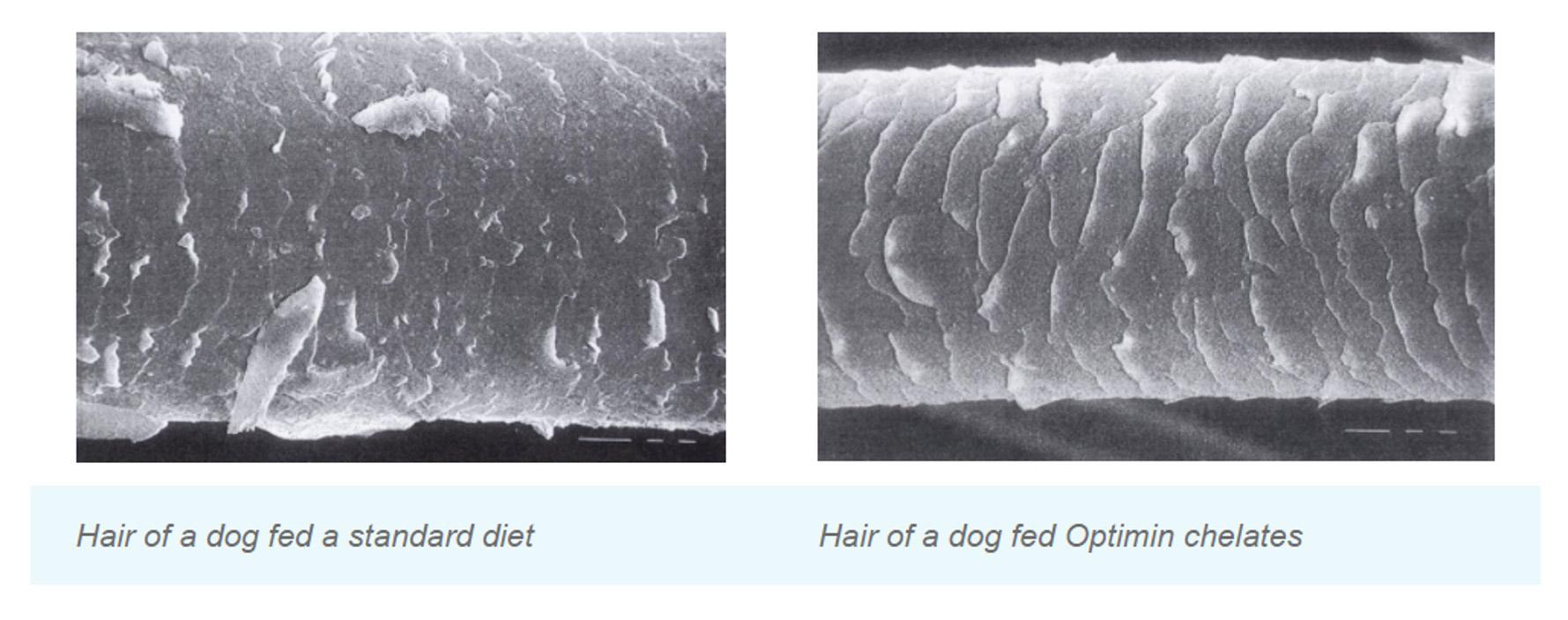
Nutrients Part of the Antioxidant Cascade Pathway
Ensuring adequate intake of antioxidant nutrients is important to help maintain normal skin health. As a barrier, the skin encounters daily oxidative challenges from the environment caused by various factors such as ultraviolet light, microbes, airborne pollutants and chemicals. As the stratum corneum (SC) is comprised of corneocytes, which are embedded in a lipid-enriched extracellular matrix (ceramides, phospholipids, sterols, free fatty acids) it means it is highly susceptible to oxidative stress. A network of enzymatic antioxidants and nonenzymatic antioxidants work together to protect its components from oxidative damage by free radicals. The enzymatic antioxidants are glutathione peroxidase, catalase and superoxide dismutase. The nonenzymatic antioxidants are tocopherol (vitamin E), ascorbate (vitamin C), glutathione and uric acid (Antille et al, 2001). Nourishing our pet’s diets with the appropriate team of key nutrients that work together to support the antioxidant pathways is therefore vital to defend delicate cellular components against free radical damage.
Vitamin E is the major cellular antioxidant present and considered to be the first line of defence against lipid peroxidation. It is also an
important constituent of sebum which is secreted onto the skin surface. Increasing vitamin E in food has been shown to significantly increase vitamin E concentrations in serum and skin of cats and dogs (Jewell et al, 2002). In addition, vitamin E levels above that of requirement decreased serum levels of some biomarkers associated with oxidative stress (Jewell et al, 2000). In dogs, plasma concentrations of vitamin E have been found to be significantly lower in atopic dogs than in healthy dogs (Kapun, et al, 2013)) with the provision of vitamin E at a rate of 8.1 iu/kg body weight resulting in improved total antioxidant capacity and reduced severity of clinical lesions (Kapun, et al, (2014)). Working alongside vitamin E, is vitamin C, a water-soluble antioxidant. Vitamin C is responsible for the regeneration of the vitamin E radical, so it is again available as an antioxidant.
Trace minerals iron, copper and zinc also support function of the enzymatic antioxidant defence system. Superoxide Dismutase (SOD) enzyme contains copper and zinc metals as cofactors; glutathione peroxidase enzyme contains selenium and catalase contains iron.
Other Vitamins
Vitamin A
Vitamin A is a fat-soluble vitamin which is essential for normal skin health and immunity. It supports the integrity of epithelial tissues and is particularly important for the keratinization process (Watson, 1998). Interestingly, an excess or inadequate intake of vitamin A causes similar skin lesions which includes skin scaling, hair loss, poor hair condition and increased susceptibility to skin infections and inflammatory skin disease (Roche et al, 2021; NRC (2006)).
B Vitamins
Pantothenic acid, Riboflavin (B2), niacin (B3), pyridoxine (B6), and biotin (B8) are all important for the quality of the skin barrier function. Several of the B vitamins support normal lipid metabolism. Riboflavin is a pre-cursor of co-enzymes FMN and FAD, which catalyse many
Pet Food SuPPlement 2023 Page 11
Journal of Nutrition 128: 2603S-2605S, 1998 Waltham Int’l Symposium, 1997
oxidation and reduction reactions. Flavin coenzymes function with transferases, dehydrogenases, oxidoreductases, monooxygenases, hydroxylases, and oxidases for reactions that desaturate essential fatty acids, form phospholipids and ether lipids, and synthesize sphingosine, cholesterol, and steroid hormones. Riboflavin deficiency results in skin characteristics similar to those observed during essential fatty acid deficiencies (Pinto and Zempleni, 2016). In dogs, riboflavin deficiency caused flaking dermatosis on the abdomen and in cats the loss or thinning of hair between the ears and the eyes (periauricular alopecia) and epidermal atrophy. Pyridoxine deficiency may impair conversion of linoleic acid to arachidonic acid (NRC, 2006). Pantothenic acid is present in the body as coenzyme A and is required for the formation of a number of essential fats and sterols by carrying and donating chemical acyl group for reactions. It is likely required for the normal formation of the lipids that form the lamellar components of the skin barrier (Watson et al, 2006). Nicotinamide is precursor of the coenzymes nicotinamide adenine dinucleotide and nicotinamide adenine dinucleotide phosphate and is involved in biosynthetic (anabolic) reactions, and is essential for the synthesis of fatty acids, and plays a role in epidermal lipid synthesis (Watson et al, 2006). It increases the free fatty acid and ceramide concentration in the keratinous film layer (Prelaud and Harvey, 2007).
coat, brittle hair, loss of hair, scaly skin, pruritus or dermatitis were given approximately 5 mg biotin/10 kg body weight/day) for 3 to 5 weeks. It was found that for 60% of the dogs all symptoms were reported to be improved after the biotin treatment and for a further 31% an improvement was noted. In only 9% no effect was recorded. (NogueiraI, et al 2010) fed 1.4mg kg-1 of body weight and found significant improvement in paw pad condition.
Gut Health and the Skin
It is now understood that dysbiosis can have far-reaching consequences and does not just affect the gastrointestinal tract but can impact other organ systems. The impact of gut microbiota on skin health is therefore an exciting and emerging area of research. The precise mechanisms by which the intestinal microbiota exerts its effects are proposed to be through effects on the immune and inflammatory systems, neuropeptide formation, metabolism, blood lipids, fat storage and short chain fatty acid production (Craig, 2016; Lee et al, 2018).
Dysbiosis has been linked to altered immune responses, promoting the development of skin diseases, such as atopic dermatitis, psoriasis, acne vulgaris, dandruff, and even skin cancer (De Pessemier et al, 2021). Establishment of microbial balance and diversity is therefore important. Allergic dogs are shown to have a significantly different gut microbiota when compared to healthy control dogs (Rostaher et al, 2022) and impairment of the intestinal mucosal barrier and increased permeability identified a risk factor for canine food allergy (Verlinden et al. 2006).
Biotin is essential for the formation and integrity of the keratinized tissues. Biotin is a required cofactor for four carboxylase enzymes which support amino-acid metabolism, cellular respiration, gluconeogenesis, and lipogenesis. Biotin deficiency has been demonstrated to reduce total fatty acid content of skin and that biotin deficiency affected keratinizing epidermal cells, as well as the composition of the intercellular cement (Proud et al (1990), Tomlinson et al, (2004)). Biotin deficiency produces alopecia around the face and eyes with crusting in severe cases (Watson, 1998). Biotin maybe provided by the dietary ingredients, a supplement and also by gut microbial synthesis. A requirement for biotin is determined for cats only. (NRC, 2006). It would however be prudent to provide supplementary biotin to dogs bearing in mind the known function of the vitamin in the skin to provide nutritional assurance of good skin and coat health. Biotin has been shown to have an impact on the condition of hair when fed to dogs (Frigg et al, 1989). Dogs suffering from dull
Prebiotics, probiotics and postbiotics are widely used in pet nutrition due to their positive effect on the gut microbiome and gut health. Both animal and human research indicates that they have a positive effect on skin by modulating the immune system and can help support the nutritional management of atopic diseases (Craig, 2016; Al-Ghazzewi, 2014; Sivamaruthi et al 2021). Natural phytogenic compounds such as citrus extract have also been demonstrated to support better epithelial cell layer structure and reduce permeability, through increased production of proteins that maintain tight junction integrity (Balta et al, 2021). This important when considering the condition of leaky gut and its potential link to dermatological issues (Nickles, et al, 2022).

Conclusion
The skin is a complex organ. Issues with skin health are detrimental to our pet’s overall wellbeing and welfare, let alone their appearance. Fortunately, the impact of nutritional intervention on skin health has been extensively researched. Optimisation of the daily diet through specific nutrient packages and nutraceuticals offers pet food, pet treat and supplement manufacturers a good opportunity to offer targeted solutions to allow pet parents to support their companions skin health and coat appearance better and conveniently.
A list of references is available upon request from the author at: sarahjane.godfrey@trouwnutrition.com
Page 12 Pet Food SuPPlement 2023
Food for pets or animal feed, a paradox for ensuring pet food safety?
By David Primrose, Petfood Consultant, Synergy Petfood
What has compound feed got to do with super premium pet food?
I want to start with a question, “What is the difference between pelletized compound feed for sheep, economy dry kibble for working dogs, game terrine for small breeds, “gourmet” chicken breast and asparagus in broth for cats and raw superfood for cats?”
As a pet owner you might think the answer is obvious, one is for feeding livestock and the other four are for feeding pets and in a simplistic way you are correct. You might also believe there is no difference as they all are formulated for feeding animals.
Although pet food marketeers or pet owners might disagree with the terminology, from a regulatory perspective all these products are classified as “animal feed”. I am not a legal expert and I am sure regulatory authorities can give compelling reasons as to why pet food is legally classified as “animal feed”.
Whether we are talking about compound feed for livestock or super premium pet food, these products share similar aims of ensuring that they meet animal nutritional requirements and the need of owners (farmers and pet owners). With some exceptions, they also share the same regulatory framework for ensuring that the food we feed is safe to eat and marketed ensuring regulatory compliance on product claims and labelling. From these perspectives, it seems reasonable that they share the same regulatory framework.
However, when pet food is perceived as “animal feed”, this can potentially result in challenges for ensuring pet food safety in the supply chain (“field-to-feeding bowl”).
“It’s only dog meat.” – A historical problem for building trust in pet food?
I am proud to say that my pet food industry career now spans over 43 years. For over 30 years, employed in one of the major global food/pet care corporations and as the owner of an independent consultancy, I have had the privilege of working across the global pet food industry sector. This experience includes working for and with pet food factories and raw material suppliers in Europe, USA, and Asia. This experience focuses on pet food quality and food safety technical risk management i.e., facilitating building trust in pet food and pet food ingredients, through a process of food safety and quality management system development, implementation, auditing, and continuous improvement.
I recall an era when some people in the supply chain believed
that pet food was “Only dog meat” and that raw materials quality and or food safety were somehow therefore not important. This misplaced view had the potential knock-on effect that raw materials produced for supply to pet food manufacturers might be subject to instances where expected quality and food safety management systems were not used by those involved. This non-compliance could, for example, result in foreign bodies in ingredient deliveries received at pet food factories. Foreign bodies like pieces of meat grinders or pieces of buckets from powder conveyors can often be accounted for due to issues like machinery breakdown / poor maintenance/failure of foreign body removal systems.
However other more “unexpected” examples of foreign bodies I have seen include items like broken plastic scoops, discarded rubber gloves, empty cigarette packets, syringes / hypodermic needles and even an empty contraceptive pill packet. Contributory factors towards the occurrence of these foreign body incidents could relate to issues like poor maintenance, lack of clear signage of “Waste Bins” and failure of foreign body elimination systems. However, another factor to consider is what we now call “Food Safety Culture” (FSC) i.e., how we think of and act when it comes to food safety. This historical perspective might arguably be an indication of what we might now consider as “poor” / “weak” food safety culture (FSC) and “immature” organisational FSC maturity.
Based on observations during audits in the pet food sector, incidents like these are much reduced and the perception of “It’s only dog meat” has diminished over the past 30 years. It should be emphasised that, although incidents like these have been observed, they were not and are not an everyday occurrence. Risk to pets is minimised/eliminated through the correct use of foreign body elimination systems like sieve screens, magnets, metal detectors and x-ray machines at pet food manufacturers’ factories and also supplier quality assurance programmes.
Food safety culture - Its importance in reducing the incidence of food safety failure and the challenge for pet food.
Many global food safety experts and regulators believe that FSC is an emerging threat to the safety of the food we eat. The question is “What is food safety culture?” and why is it important in ensuring safe food for humans and pets?
Pet Food SuPPlement 2023 Page 13
What’s in a name?
For many years food safety management systems (FSMS) based on Hazard Analysis and Critical Control Points (HACCP) have been designed, implemented and used with the aim of ensuring food safety by elimination, prevention and reduction of food safety hazards that might cause illness or death e.g., chemical, physical and biological hazards.
However, people do not always do what a system or procedure says they should do and the risks of food safety failure can increase. Examples include the foreign bodies incidents discussed above, failure to carry out temperature checks, failure to comply with maintenance programs or comply with plant hygiene procedures and schedules.
It is for these reasons that food safety culture (FSC) also known as food safety behaviour is important. We can think of FSC as the difference between what we expect people to do and what they think and actually do.
We also see this in other aspects of everyday life. For example, the law might state that we should wear a seatbelt when in a car, do not use a mobile phone when driving and stick to the speed limit. However, the reality of life is that humans do not always behave in a way required to comply with regulatory requirements. Consequently, we see car occupants not wearing seatbelts, talking or texting on their mobile phones whilst driving or driving above the legal speed limit. These incidences of non-compliance increase the risk of failure, potentially with serious outcomes e.g., injury or death through not wearing a seatbelt.
Arguably the important concept of FSC didn’t exist from a practical perspective in the 1990’s when some of the food safety issues outlined above were identified. However, it is not unrealistic to believe that rubber gloves in a bin of meats might relate to the concept of “weak” or “negative” FSC / behaviour or an “immature” FSC organisation i.e., the gloves were discarded in the incorrect waste bin in a failure to behave according to procedures. This could be a result of many factors including lack of leadership, mentoring, training, communication etc.
This leads us to consider how the perception of pet food as “animal feed” might also contribute to “weak” FSC and “immature” FSC maturity across a business. In an organisation with “low” FSC maturity, we see gaps between what we expect people to do and what they actually do. This might mean for example that some people have the belief that the bin contains waste for “animal feed” and it doesn’t matter if rubber gloves are discarded in it. However, the valuable, useful ingredients might have to be scrapped due to food safety risks.
Conversely in an organisation with “strong” / “positive” FSC maturity, and where animal feed is seen as “food for pets, fewer gaps exist between the food safety management expectations and the reality i.e., people believe in food for pets and think about quality/food safety systems in a positive way and comply with what they are expected to do, meeting expectations and reducing the risk of food safety failure. Think also about the fact that pet food ingredients contaminated with foreign bodies might have to be scrapped leading to waste, costs of disposal and costs of replacement. In this context a positive FSC, contributes to business efficiency, improving the bottom line and helping with sustainability.
A key part of the food safety risk management of pet ingredients for over 30 years, has been the importance of education. One key aim is raising awareness through training and mentoring in changing the mindset/perception from one of “animal feed” (“It’s only dog meat”) to thinking of it as food for pets. Whilst pet food might legally be classified as “animal feed”, in terms of building trust, reducing food safety risk and developing a mature FSC we must think of it as food for pets rather than feed for animals.
However, FSC maturity does not happen overnight and raising awareness/training is only part of the requirements on a journey where FSC maturity can bring business benefits beyond a reduction in pet food safety hazards.
FSC and FSC maturity development – where do we start?
It is beyond the scope of this current article to provide a detailed discussion on how to transition from a traditional process-based food safety management system (HACCP Plan) to the development of a “behaviour-based” system that builds on the HACCP Plan with the addition of FSC. Achieving FSC maturity and making this transition takes time and significant commitment from the senior leadership team including the owner / managing director / C suite managers. The Global Food Safety Initiative (GFSI) defines FSC as follows: -
FSC = Food Safety Culture: Shared values, norms, and beliefs that affect mindset and
towards food safety across/in/ throughout
an organisation. (GFSI, 2018)
The concept of FSC originates from an understanding of areas outside traditional food safety management and builds on learnings from diverse fields including: - Organisational culture and psychology; human factors research; safety science; social science and diverse cultural beliefs.
Many models exist for understanding FSC but each can be distilled into the following key elements: -
• with business strategy
Vision & Mission – Leadership and alignment of pet food safety
• make a FSMS live (or die)
People – People make the pet food/ingredients and they also
Consistency – Consistency, communication and accountability
• ensure that business practices and resources are aligned with the business food safety vision and policy
• compromising food safety policy
Adaptability - Learning and vision to adapt to change without
• sharing to raise awareness and ensure adaptability.
Hazard and Risk Analysis - Horizon scanning and knowledge
These models can be used for benchmarking where an organisation is and enables us to identify and implement development needs. Importantly it requires access to and use of independent assessment of the level of FSC maturity, against which progress can
Page 14 Pet Food SuPPlement 2023
behaviours
be monitored. It is worth remembering the quality philosophy of “What doesn’t get measured, doesn’t get controlled.”
Within an organisation, some keys to success include the following practical steps and thinking on ways of working: -
• managers’ visibility (walking the talk)
•
Engagement throughout the organisation including senior
Training and mentoring (food safety and changing mindset)
level of waste. Both these can have a positive effect on business performance and increased profitability. Assuming open/transparent communication, the benefits also help fuel positivity and a sense of belonging in the business.
Food Safety Culture - Challenges and opportunities for the pet food sector
•
On-going communication, including KPIs
Business culture that encourages openness, transparency and
• that includes a system where disciplinary action can be taken or success is rewarded.
FSC maturity level in the pet food industry
Using the UK as an example, it is worth noting that a number of pet food manufacturers are certified by the globally recognised British Retail Consortium Global Standard Food Safety (BRCGS). BRCGS Food Safety is one of the independent standards recognised by GFSI. With respect to FSC, this is important as the BRC standard means that certified food business operators (including pet food companies and ingredient suppliers) must meet defined FSC requirements to achieve certification. Based on the fact that there are several businesses in the UK that have achieved BRCGS Food Safety certification, this means they are already working on FSC maturity and may have a stronger FSC than non-certified companies.
However, based on audits carried out at non-BRCGS certified companies in the UK, where the author has benchmarked FSC maturity, it is clearly evident that active progress is being taken at other pet food producers to develop their FSC maturity. Whilst a detailed assessment protocol is also required, evidence of FSC maturity can be seen in how people talk and think about pet food safety and how they talk knowledgeably and with pride about their business.
It is, however, unknown how widespread a positive FSC ethos is within the pet food industry or what the level of maturity across the sector is at this point in time.
The economic benefits of organisational FSC maturity
Sadly we live in challenging times in an increasingly volatile, uncertain, complex and ambiguous (VUCA) geopolitical world. This sees everyone, including the pet food sector facing major challenges and crises like war, spiralling inflation, Covid, energy prices, material supply and climate change. The question is why should a business in the pet food sector embark on the development of their FSC maturity?
Whilst it might be evident that FSC has a beneficial impact on building trust in safe pet food, by reducing risk of food safety failure, other benefits can be achieved. We have already outlined how food safety failure like foreign bodies can result in waste, cost and reduced profitability and developing a more positive business culture that can impact all areas not only food safety improvement.
Searching publicly available information on the internet, potential benefits arising from a strong/positive FSC maturity include reducing the level of non-conformities /associated costs and reducing the
In many ways, development of FSC maturity in the pet food industry faces the same challenges as the human food sector. These include, but are not limited to, the use of short-term contract workforce which means that staff turnover can be “high” and the scenario that the workforce might be multicultural presents additional language and cultural belief challenges. However, experience in the food industry shows these challenges can be overcome and a pet food business operator manufacturing pet food or pet food raw materials can embark on their FSC maturity journey.
The key first step is for the business owner / CEO / Managing Director to understand the commitment required and provide both leadership/resources including time (FSC maturity does not happen overnight) and money.
A pre-cursor to embarking on the FSC maturity journey is to continue influencing and changing any mindsets in people who might still consider pet food as animal feed rather than food for pets. Working with supplier quality and purchasing functions, this should also be positively reinforced across the supply chain from “field- to – feeding bowl”, ensuring the messaging is not only restricted to marketing communication for the products we market and sell.
If still unsure about developing your FSC, a further consideration for senior management is if we don’t commit to FSC development are my competitors benefiting from it and putting our business at a commercial disadvantage?
About the author
With over 43 years experience, author David Primrose considers himself a veteran of the global pet food industry. After a 27 year career with Mars Petcare, that largely focused on raw materials technical risk management (specifications, quality and food safety) he established his independent technical consultancy “Synergy Food Ingredients” (Trading as “Synergy Pet food”) in 2006. His technical consultancy focuses on developing trust in pet food and pet food ingredients by working with clients to develop better people, systems and products. Areas of specialty include raw materials risk management, supplier assurance, food safety, food authenticity and more recently food safety culture. He has an MSc in Food Safety Management.
Synergy Petfood | www.synergy-petfood.com

Pet Food SuPPlement 2023 Page 15
The Natural Way to Support a Pet’s Gut Health
With Dr Maygane Ronsmans, Product Manager Animal Nutrition, BENEO
Gut health is big business in human and animal nutrition. However, not all added fibres have been created equal. Here Dr Maygane Ronsmans, Product Manager

Animal Nutrition at BENEO, discusses why prebiotic chicory root fibres are best for promoting gut health and the other range of benefits they can offer pet owners and pet food producers alike.
For some time now, animal digestive health has been tracking the popularity seen in human nutrition. In fact, even before the pandemic had made pet owners more health conscious, a study showed that 76% of cat and dog owners believed that actively looking after their pet’s digestive health was essential for their overall health. Following the global research in 2021, BENEO was able to identify ten key drivers that cat and dog owners perceived were vital to making pet foods seem healthier.
Ten key drivers to healthier pet food perceptions
Almost 90% of cat and dog owners said that using natural ingredients was their number one way for pet food to seem healthier to them, closely followed by using less or no preservatives and additives. Reducing fat and adding fibre were seen as strong influencers by over 80% of pet owners, and of similar importance was having recognisable ingredients on the label, that were also not genetically modified. Three quarters also wanted to know where the ingredients had been sourced from and they wanted to see a short ingredients list on the pack. Interestingly, plant-based ingredients and the addition of prebiotics also made products seem healthier to over 70% of cat and dog owners.
Digestive health becomes mainstream
With added fibre and prebiotics two of the key drivers to make pet food seem healthier to pet owners, it is no surprise that digestive health has well and truly moved into the mainstream. In fact, 83% of dog and 84% of cat owners consider digestive health as extremely or very important. Today around 1 in 4 global new pet food products promotes a digestive health claim or prebiotic benefit on the package. The link between a pet’s digestive health and their overall health has been made by pet owners, however, not all fibres are the same. At present, a wide range of fibres can be used in dog foods. These include insoluble fibre sources such as cellulose or blends of insoluble and soluble fibres, which include sugar beet pulp and wheat bran, as well as fully soluble fibre sources such as
inulin-type fructans. Based on the fibre type, they behave differently in a pet’s digestive system, significantly influencing their potential digestive health benefits.
Why is prebiotic fibre important?
Dietary fibre is the indigestible part of plant material and can be soluble, insoluble or a mix of the two. Insoluble fibres can create bulking and a longer feeling of fullness, while also supporting bowel function. Soluble fibres include fermentable fibres (such as those found in sugar beet pulp) and prebiotic fibres. While both are dissolved and fermented in the colon, only prebiotic fibre sources like inulin-type fructans specifically feed healthy gut bacteria when they reach the colon. Prebiotics are “a substrate that is selectively utilised by host microorganisms conferring a health benefit”. Both the criteria for feeding beneficial bacteria and conferring a health benefit need to be fulfilled for an ingredient to be defined as a prebiotic. In comparison to other fermentable fibres, chicory root fibres - namely chicory inulin and oligofructose - are natural prebiotics for many animals like cats and dogs and they support a healthy microbiota along with other health benefits.
Products masquerading as prebiotic
With almost 80% of respondents stating that “prebiotic” on-pack communication affects their interest in buying a certain food for their pets, this has led to some suppliers making unfounded ‘prebiotic’ claims for their products. In the pet food industry at present, there are a profusion of products that are being promoted as prebiotics but in fact aren’t (such as fermentable fibres-containing ingredients, or even resistant starches). However, the only established prebiotics that have been scientifically proven to selectively encourage the growth of good bacteria and deliver related health benefits in humans - with corresponding evidence in pets as well - are inulin-type fructans, including BENEO’s natural chicory root fibres Orafti ® Inulin and Oligofructose.
When the chicory root fibres reach the colon, they are selectively fermented by the good microbiota residing in the pets’ intestine, such as bifidobacteria, and selectively stimulate their growth and proliferation. Additionally, their fermentation by selected microbiota results in the production of Short-Chain Fatty Acids (SCFAs), namely acetate, propionate, and butyrate. These fatty acids decrease the lumen pH in the gut and enhance its structure. They also strengthen the gut mucosa’s barrier against pathogenic bacteria, as butyrate is the primary source of energy for the intestinal cells.
Page 16 Pet Food SuPPlement 2023
Scientifically proven prebiotic effect
BENEO’s Orafti ® Inulin and Oligofructose have been studied extensively for over two decades both in human and animal nutrition, and the scientific foundation for their prebiotic effect is strong. In human nutrition, a recent systematic review with meta-analyses that applied the Cochrane methodology (considered the strongest methodology in the hierarchy of scientific evidence) and was based on intervention studies, confirmed the prebiotic effect of inulin-type fructans sourced from the chicory root. In dogs and cats, studies have shown that the selective fermentation of chicory root fibres Orafti® Inulin and Oligofructose by specific beneficial bacteria leads to an increase in SCFA production, and is linked with nutritional benefits for pets, that go beyond the gut. For instance, as part of their prebiotic effect and effect on digestive health, chicory root fibres support calcium and mineral absorption in dogs. Further research has shown that chicory root fibres can support blood sugar management in dogs as well as weight management in both, dogs and cats.
rise in postprandial blood glucose or insulin concentrations. Hence, they support blood sugar management in dogs. What’s more, studies in dogs have shown that feeding them with chicory prebiotics can allow for a lower blood sugar response after a meal and this benefit can extend to a subsequent meal taken hours later, even if that meal doesn’t include chicory root fibres; which is called the second meal effect.
Absorption of minerals and bone health
The absorption of minerals is essential to an animal’s growth and bone strength. From their selective fermentation which produces SCFA, inulin-type fructans reduce the luminal pH and nurture the intestinal mucosa with butyrate, thereby allowing for additional calcium absorption in the lower gut (the colon). Studies with oligofructose have demonstrated increased mineral uptake in dogs, and among others calcium, thereby, supporting bone health.
Supporting weight and blood sugar management
Being overweight or obese is common in companion animals, and according to a 2019 report from the UK’s Pet Food Manufacturers’ Association, 51% of dogs and 44% of cats in the UK are classified as such. As well as supporting a pet’s intestinal health, chicory root fibres also show positive effects related to weight management in pets and blood sugar management in dogs. First studies show that including Orafti® Inulin and Oligofructose in a pet’s diet can curb their appetite, improve satiety and hence decrease voluntary food intake. In doing so, chicory root fibres help to maintain the healthy condition of a pet’s body. Additionally, since inulin-type fructans are non-digestible carbohydrates and dietary fibre, they do not trigger a
Support of renal health in cats
Cats are sensitive to kidney disorders as they age, and one indicator of a problem can be elevated levels of blood urea nitrogen. Typically, in healthy animals, the liver produces urea to clean up the nitrogen from the blood, which then travels to the kidneys through the bloodstream, where it is then filtered and excreted in the urine. In ageing cats, this renal metabolism might become less effective and nutritional solutions, amongst other things, could be supportive. Inulin-type fructans such as Orafti® Inulin and Oligofructose have been shown to induce a shift in nitrogen metabolism, through increased nitrogen excretion via the faeces and decreased clearance in the urine, representing a potentially valuable nutritional support for renal function.
With owners concerned about ingredient labels and their pet’s long-term health, chicory inulin-type fructans are well placed for both cat and dog food product development that delivers natural support to a pet’s intestinal health. BENEO’s Orafti® Inulin and Oligofructose are produced from non-GMO chicory roots, which are locally sourced from farmers close to the production sites. Processed in two state-ofthe-art plants in Belgium and Chile, both of which have food and feed certification, these functional dietary fibres meet the highest safety and quality standards. They are acknowledged as feed materials in the EU (EU Catalogue of Feed Materials, EU 2017/1017) and some of them by the AAFCO in the US. Orafti® Inulin and Oligofructose can be qualified as natural ingredients and used in both dry and wet pet foods, or in snacks. BENEO offers a customisable range of chicory prebiotics that is suitable for a wide range of life stages and animals.


Natural, recognisable, and health-promoting ingredients are key drivers to pet food purchasing. With more and more owners making label-based choices, BENEO’s chicory root fibre ingredients are valuable assets that help manufacturers deliver quality pet food products with a range of health benefits, and whose natural credentials appeal to pet parents.
BENEO source references for this article are available on request from: contact@beneo.com
Pet Food SuPPlement 2023 Page 17
SmartMoisture
Improving sustainability in pet food production
By Victoria Thornber, Companion Animal Manager , Devenish
The need to improve sustainability in pet food production, be that financial or environmental has never been greater. Raw material costs have skyrocketed over the past 18 months and consumer demand to create more from less continues to intensify. So how do we as pet food manufacturers improve?
SmartMoisture, a patented moisture management solution from Devenish can help on both fronts.
SmartMoisture acts to allow better penetration of water and steam during pet food production, bind said water within the petfood kibble and reduce water activity thereby preventing mould growth.
What is water activity and what impact can it have on feed?
Moisture content merely describes how much water is in the product. Water activity describes how much of that water is free and therefore available to microorganisms for growth. Hot temperatures cause water to migrate during storage, while humid conditions will result in condensation, both resulting in higher activities of free water. The growth of microorganisms will be hindered when the water activity of a pet food reaches below 0.9 for most bacterial pathogens and below 0.67 for most moulds. By managing the water activity of pet food during processing and storage, we can reduce the proliferation of microorganisms and ensure food safety.
Heat-treatment steps can kill bacterial pathogens such as Salmonella , but moulds are stable and won’t be destroyed. This has necessitated the need for alternative solutions such as SmartMoisture.
Patented solution stabilising propionic acid


SmartMoisture consists of a combination of propionic acid esterified to glycerol, buffered formic acid, and surfactants. It is 30% more concentrated than any other product on the market due to the stability of the glycerol esters. The propionic acid esterified to glycerol is a patented process used to buffer and stabilise propionic acid (Figure 1). It increases the retention time of propionic acid in pet food, ensuring longer-lasting microbial inhibition. Glycerol acts as a humectant and emulsifier and can hold up to 1,000 times its own weight. The
surfactant reduces the water’s surface tension, therefore improving moisture distribution. Glycerol and the surfactant improve water absorption into feed particles and help to stabilise water activity.
Stability of Propionic Acid from SmartMoisture
European pet food trial
In a recent trial, a European pet food producer faced transport challenges associated with shipping pet food to tropical regions. As such, the company kept pet food moisture levels below 7% to reduce the risk of microbial growth.
The trial assessed two treatments:
Control: No SmartMoisture with moisture level reduced to • 7%
Treatment: Maximum of 750g/ton SmartMoisture inclusion with • moisture level ‘increased’, or ‘dried to’ to 9%
SmartMoisture was added in the mixer with all the usual liquid additions. Samples were taken after production and at bagging. Moisture percentage and water activity were measured.
Results: Reducing water activity with a higher moisture content
SmartMoisture consistently kept aW below 0.5 even at higher moisture levels, thus allowing the dog food to be dried off to a higher moisture

Page 18 Pet Food SuPPlement 2023
Figure 1:
content. Bulk production increased without compromising quality. Throughput was also improved with kibble spending less time in the dryer and cooler.
The humectant properties of SmartMoisture stabilised the water activity when the dog food was dried to a higher moisture content. The propionic and formic acid, as part of the glycerol esters, were absorbed into the feed particles ensuring a stable product that is protected against microbial growth.
This gave this customer confidence to ship food at a higher moisture content, thereby increasing yield and profitability.
Sausage treats incorporationg 0.2% SmartMoisture (below) and without SmartMoisture (above)

incorporating 0.2% SmartMoisture in the production of sausage treats, drying time was reduced by approximately 20%, resulting in a more plump, fuller-looking product and reduced production costs.
A second trial, carried out by another dog food manufacturer delivered similar results. Additional moisture was included at 2% with a water/SmartMoisture solution. Final moisture saw an increase of up to 3% in the final dog food with water activity remaining within the targeted KPI levels. SmartMoisture gave improvements in production efficiency with extruder throughput improving up to 18.0%.
Improving product form in semi-moist production
The ability to reduce drying time, maintain higher moisture levels and keep water activity low can also have an additional benefit in semimoist food production in improving product form.
A recent trial with a European producer of semi-moist products showed how reducing drying time not only saved energy but also improved the visual appearance of the finished product. By
Multiple benefits for pet food producers
In summary, benefits seen from the inclusion of SmartMoisture in pet food production include:-
• reducing the risk of mould growth and moisture migration
Pet food moisture content can be safely increased whilst
Improved
• shelf life
• manufacturing costs via:
Financial and environmental sustainability benefits by reducing
o
Energy savings (kwh needed per ton of food produce
o
Throughput improvements in production

•
Improved product form
For more information visit www.smartmoisture.com or contact your local Devenish representative.
Water activity of SmartMoisture included in pet food

Pet Food SuPPlement 2023 Page 19
“
… The humectant properties of SmartMoisture stabilised the water activity when the dog food was dried to a higher moisture content.… “
The Invisible Link Between Nutrition and Mental Health
By Dr. Robert Falconer-Taylor, BVetMed, DipCABT, MRCVS, EMOTIONS-R-US and Francesca Susca, DVM, PhD, Global Pet Development Manager, Lallemand Animal Nutrition
Humans and dogs have shared a special bond for more than 35,000 years since first working and living together. Dogs are regarded as a member of the family in most households and their behaviour directly affects the overall family’s well-being. Behavioural problems are common among our canine companions and dogs experience anxiety mainly related to separation, fear and ageing. Aggression, excessive barking, restlessness, compulsive and destructive behaviours are all signs of fear and anxiety in dogs and if disproportionate levels of anxiety are left unchecked, a dog can develop an anxiety disorder. These disorders can negatively affect a dog’s physical health and wellbeing but also affect the relationship with the owner and the entire family’s quality of life.

The Seeking system is the primary driving force underpinning the other emotional systems. It powers the dopamine-driven arousal and motivation that compels us to go out and engage with the world, exhibited in a dog’s enthusiasm and excitement at the prospect of going out for a walk. Anxiety engages the Seeking system to avoid, while depression shuts the Seeking system down.
1. The Anatomy of Canine Emotionality
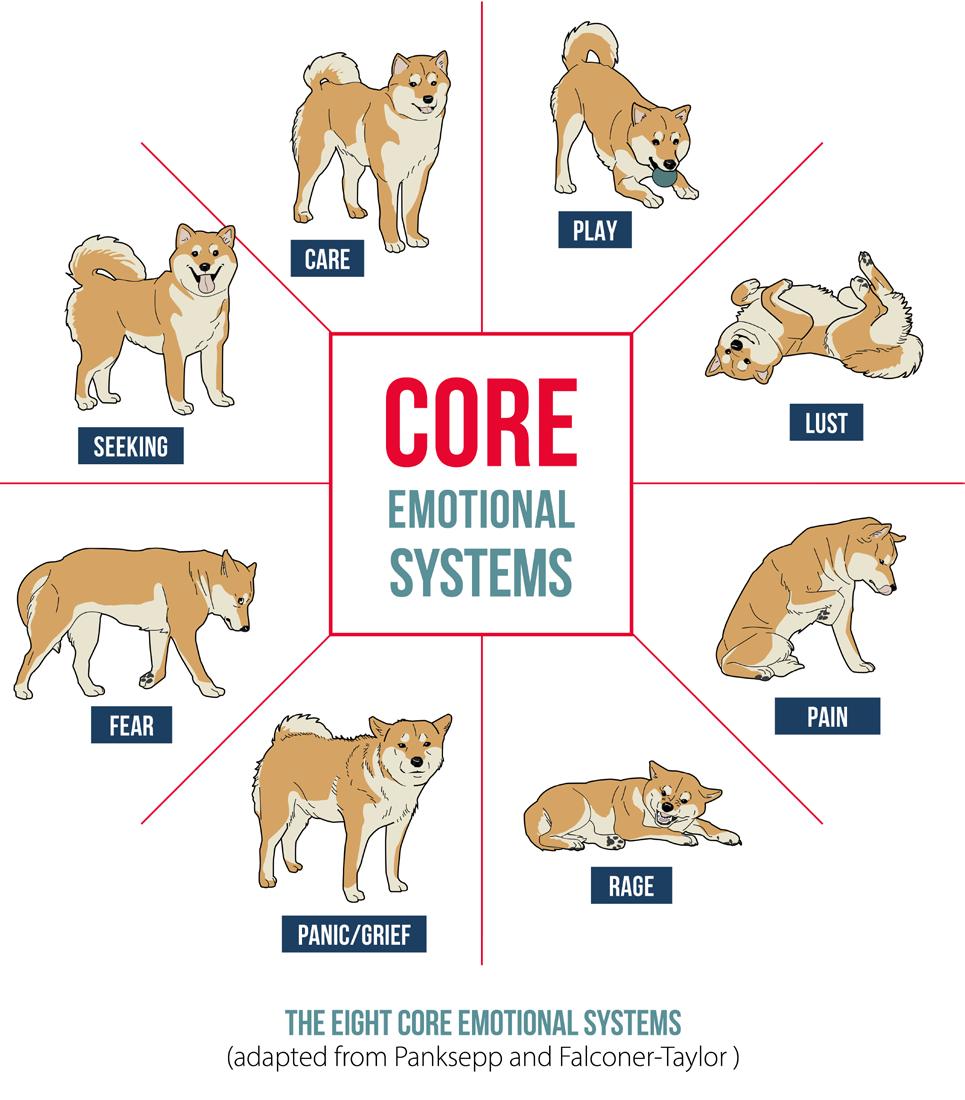
During the 1980s and 1990s, neuroscientist Jaak Panksepp meticulously mapped out the emotional systems of mammals, allowing us to learn about how they work and how and why they may go wrong (Panksepp, 1998, 2005). Panksepp identified seven basic, core emotional systems located deep in the midbrain: Seeking, Fear, Rage, Lust, Play, Care and Panic/Grief. Robert Falconer-Taylor, veterinary behaviourist, later added Pain into the overall schema, as chronic pain plays an important role in behaviour problems in dogs. These core systems are the basic building blocks on which all other emotional experiences (subjective feelings) are built.
Lust, Rage, Fear and Pain are the emotions that ensure survival. Fear and Pain systems are closely linked because pain causes fear, unresolved fear leads to anxiety, unresolved anxiety leads to depression, and depression shuts down the Seeking system.
The Play, Care and Panic/ Grief systems are more sophisticated social systems, vital for safe, cooperative living. The Panic/Grief system is particularly important because it is the emotional system responsible for separation anxiety in dogs. Separation anxiety is the second most common behaviour problem, accounting for between 20% to 40% of a canine behaviourist’s caseload (Landsberg et al., 2008; Ogata, 2016). Like children, dogs form very strong and enduring social attachments with their human families, but when dogs have not learned that it is safe to be left alone for short periods
Page 20 Pet Food SuPPlement 2023
of time, the Panic/Grief system is engaged. The Panic/Grief system is coupled directly to the Pain system, which is coupled to the Fear system, which is why separation anxiety can be so hard to treat. Like anxiety, it is another vicious cycle that feeds itself and will get worse without intervention.
2. How to Assess Emotional State in Dogs

Two key factors in understanding behaviour are emotional state and mood state. Every emotional state has two fundamental properties – a feeling state and an arousal level. Feeling states are on a spectrum, ranging from as happy as you could possibly be, to as unhappy as you could possibly be. Every feeling also has an arousal level, ranging from: as excited as you could possibly be, to a calm and relaxed midground, through to as terrified as you could possibly be. Emotional states change very quickly from one moment to the next depending on events throughout the day, whereas mood states are resistant to change. This is why anxiety and depression are classified as mood state disorders.
3. How to Assess Mood State in Dogs

Mood state can be estimated as a reasonable average of all the emotional states experienced over a given period. To assess your dog’s mood state, make an estimate of your dog’s emotional state 3 times per day over a period of 7 to 10 days and plot it on the mood scale. Here is an example of a good mood state (below left) and a poor mood state (below right). These subjective analogue self-report estimates of ‘how you are feeling’ are routinely used by human mental health professionals. More recently, they have also been employed in animals, including dogs and farm animals (Baciadonna et al., 2018; Mendl et al., 2010; Paul et al., 2020). If your dog has a negative mood state, seek professional behavioural support.
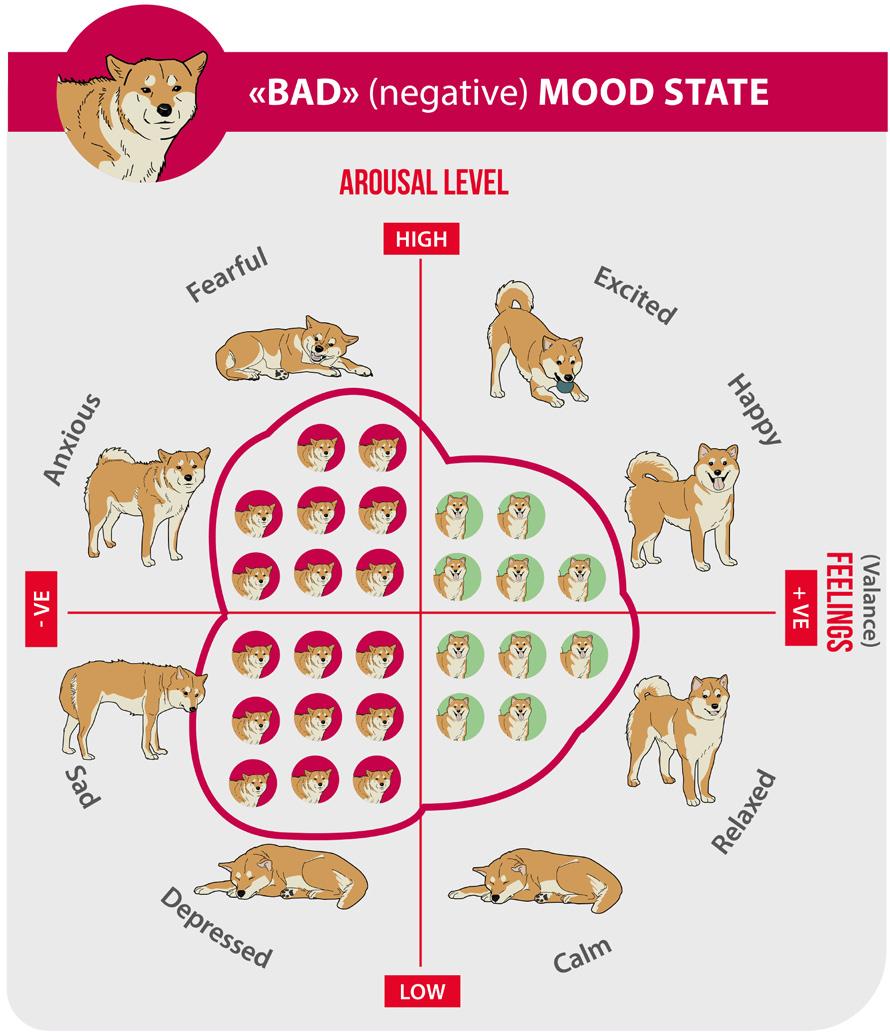
4. The Second Brain and Mental Health
The gut microbiota plays a central part in the maintenance of overall pet physical and mental health. It can influence mental health and emotionality both positively and negatively and has at least five distinct communication channels to the brain (Anglin et al., 2015). The enteric nervous system, our ‘second brain’, is so extensive that it can operate as an independent entity. Its role is to monitor and integrate gut function as well as to link emotional and cognitive centres of the brain with peripheral intestinal functions and mechanisms such as immune activation, intestinal permeability, enteric reflex, and entero-endocrine signalling. It generates over 30 different neurotransmitters, including 95% of the production and storage of serotonin, and is responsible for enteroception, commonly known as our ‘gut feeling’.
Pet Food SuPPlement 2023 Page 21
Prebiotics, probiotics and postbiotics are able to modulate the host microbiota and are scientifically relevant tools when dealing with behavioural issues in pets. Prebiotics contribute to the scaffolding needed to support the microbiota and in turn to support the host. Probiotics offer a practical solution to help restore depleted or damaged microbiota populations under a state of dysbiosis. Stress-related chronic gastrointestinal diseases are very common in human medicine and in dogs, for example, Irritable Bowel Syndrome (IBS) and Inflammatory Bowel Disease (Crohn’s disease).
Many studies have shown the benefits of using both prebiotics and probiotics to treat stress-related diseases in humans and dogs as there is often a link between chronic stress, poor mental health and chronic gastrointestinal disease (Pinna and Biagi 2014).
Understanding your dog’s emotional state can help you to recognise when their emotional well-being is at risk. Experiencing negative emotions over a long period of time will negatively influence your dog’s mood state and can contribute to the development of behavioural problems. The gut microbiome plays a central role in the maintenance of overall physical and mental health via the enteric nervous system: the gut-brain axis. Pre- and probiotics can modulate the host microbiota and are scientifically relevant tools when dealing with behavioural issues in pets. By educating ourselves about our dog’s nutritional and emotional needs, we can support overall well-being and reinforce our special and unique bond with man’s best friend.

Did you know?
More than 100 trillion microbes are estimated to be residing both inside and over the surface of humans (Wang et al., 2017). The human genome consists of about 23,000 genes, whereas the microbiome genome encodes more than 3 million genes, producing thousands of metabolites with metabolic functions for the host. Humans are made up of as many microbes as human cells and optimal health requires a balance between a host and its microbiota. The 500 million neurons within the enteric nervous system allow the brain and gut to communicate. Due to this, the microbiome is now viewed as a potential biomarker for mental disorder stratification and a predictive model for treatment resistance. Find out more at Cerebiomebylallemand.com and discover how unique psychobiotics can positively influence psychological stress in humans.

Page 22 Pet Food SuPPlement 2023
SPECIFIC FOR YOUR SUCCESS
NATURAL MICROBIALS FOR PET WELL-BEING
As your partner, Lallemand Animal Nutrition develops, produces and markets a complete range of high-value yeast and bacteria products –including paraprobiotics and yeast derivatives– specifically selected to help you improve companion animal well-being in a natural way.

LALLEMAND ANIMAL NUTRITION SPECIFIC FOR YOUR SUCCESS www.lallemandanimalnutrition.com + 44 (0) 1684 580022
ENHANCE DIGESTIBILITY SUPPORT IMMUNITY CONTROL OXIDATIVE STRESS
The Unrivalled Benefit of Betaine in Pet Food
By Pauline Rovers-Paap, Central Technical Manager, Orffa Additives, the Netherlands
Betaine is a functional nutrient with interesting osmoprotective properties and is a well-known methyl (CH3) donor in animal metabolism. In spite of the beneficial functionality of betaine in animal nutrition, there is no nutritional requirement identified for the application of betaine in pet food. The nutrient is not even mentioned in the Nutrient Requirements of Dogs and Cats (NRC, 2006) or in the latest FEDIAF Nutritional Guidelines (2021). Yet, particularly based on recent research, betaine has some unique properties to support pet health and pet food production.
Methyl donors and transmethylation
In the animal body, betaine is a natural metabolite in the transmethylation metabolism (Figure 1). Like folate (vitamin B9), cobalamin (vitamin B12) and choline, betaine has a specific role in the existing methyl transferation pathways to remethylate homocysteine into methionine. Although there is no specific requirement described for the total amount of methyl donors in pet food, a certain balanced minimum of these different methyl group donors is needed1. Methylation is involved in many important metabolic processes and in the expression of genes (DNA-methylation). The methyl group donations are also essential to maintain normal liver function, like the prevention of fat accumulation in the liver (read more about fatty liver prevention in the blue box).
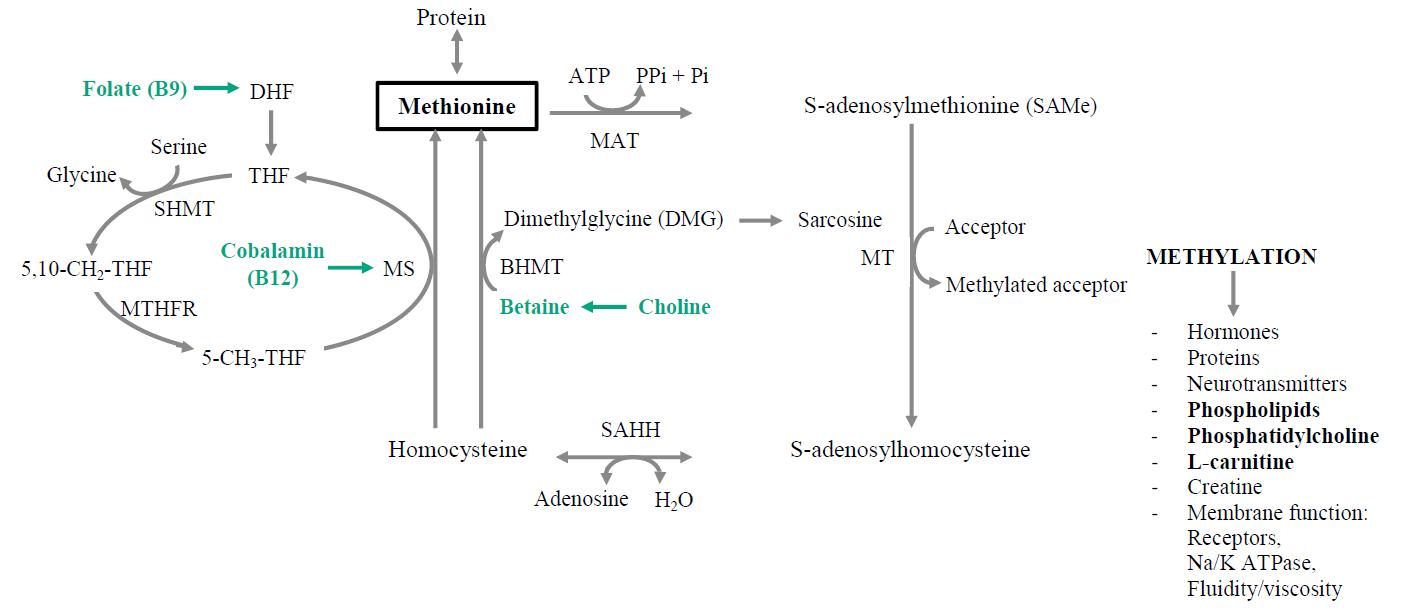
Choline in the metabolism
In the classical sense, choline is not a true vitamin as animals are able to synthesize choline in the liver. Yet, choline is traditionally added
within the vitamin B-complex to pet food, as the de novo synthesis can be inadequate under some conditions. Supplementation of the diet with small amounts of choline can prevent certain pathological conditions. Choline, per se, is essential as a building block for acetylcholine and phosphatidylcholine. Acetylcholine is an important neurotransmitter that plays a role in body functions such as muscle contractions. Phosphatidylcholine is a structural component of (cell)membranes and is a required element of very low density lipoproteins (VLDL). VLDL are crucial in the energy metabolism and prevention of fatty livers, as they play an important role in the mobilisation of triglycerides from the liver and their delivery to other animal tissues. Like in other animal species, suboptimal concentration of (phosphatidyl)choline in the pet’s diet is associated with a reduced capacity of the liver to synthesize VLDL, which results in the accumulation of fat in the liver of dogs and cats1. A second functional role of choline is the delivery of methyl groups for transmethylation reactions (Figure 1). As a methyl donor, choline provides active methyl groups for the remethylation of homocysteine into methionine. From methionine, S-adenosylmethionine (SAMe) can be formed. SAMe is involved in more than 60 metabolic reactions, which play an important role in a multitude of metabolic pathways, such as cell replication, synthesis of neurotransmitters, phosphatidylcholine, phospholipids, L-carnitine and membrane functions1
Page 24 Pet Food SuPPlement 2023
Figure 1: Methyl donors and important cofactors (in green) within the (trans)methylation metabolism, essential in many metabolic processes (adapted from Verbrugghe and Bakovic, 2013).
Choline vs. betaine as a methyl donor
Betaine is closely linked to choline due to its relationship within the transmethylation pathway, which allows for the use of betaine to partly or completely replace choline chloride in animal diets. Both dietary components can be supplemented to the feed, to be used as a methyl donor in the transmethylation metabolism (Figure 1). For the delivery of free methyl groups, choline needs to be converted into betaine via an irreversible 2-step oxidation reaction in the mitochondria (Figure 2). The required conversion of choline into betaine makes betaine a more efficient methyl donor compared to choline.
Research with betaine in cats and dogs
The replacement of choline chloride with betaine in diet formulation is common practice in livestock nutrition. In pet food, there is less experience with the exchange of both functional nutrients. Until a few years ago, no scientific research was available about betaine in pet diets. Recently, several articles have been published and it is now clear that both dogs and cats can use betaine as a methyl donor, gain benefit from the osmoprotective function, and utilise other functionalities.
Choline used to compensate for low betaine levels
Figure 2: For the delivery of free methyl groups in the transmethylation metabolism, choline is converted to betaine via an irreversible 2-step oxidation reaction in the mitochondria. The + and - signs show the specific characteristic of betaine as a zwitterion, illustrating the protective osmolyte function.

Betaine as a protective osmolyte
Supplemented betaine, which is not used as a methyl donor, can be used by (stressed) cells as an osmoprotectant. As a complete molecule, betaine has a neutral charge, but it has a region of both positive and negative charges (Figure 2). Having this specific characteristic, betaine is a zwitterion (dipolar ion) and this allows betaine to be both highly water soluble and able to hold water molecules. When betaine is taken up inside cells, it increases the water retention capacity of the cells. Thereby, betaine improves the cellular water balance in the gut, muscle and animal tissues. A better water balance by organic osmoprotectants, such as betaine, relieves the pressure on the ion pumps and stabilises the electrolyte concentration in and out of the cell. Thereby, betaine protects cells from the negative effects of dehydration, which results in reduced cellular activity, protein denaturation and loss of enzyme production. Higher plasma levels of betaine are advantageous, as it will increase the tolerance of cells to unfavourable conditions (e.g. in cases of renal failure).
In a cross-over study with healthy dogs, comparing a traditional dry extruded diet with a plant-based diet, the circulating plasma levels of betaine and choline were both lower when the plant-based diet was fed2. The background level of betaine in the plant-based ingredients was significantly lower (Table 1), explaining the lower betaine levels in the plasma. However, the dietary choline levels were comparable between both diets due to the supplementation of choline chloride (on top of the choline present in food ingredients). The observed lower choline plasma levels could be explained by a lower absorption and/or de novo synthesis of choline in dogs receiving the plant-based diet. Alternatively, the lower plasma choline could be explained by the increased oxidation of choline to form betaine, for the delivery of sufficient methyl groups2. This suggests that in dogs, more choline will be used as a methyl donor, to compensate for low betaine levels within pet food.
Betaine is a methyl donor in pets
Supplementation of betaine in pet food resulted in higher betaine plasma levels in both dogs3,4 and cats5,6. Moreover, additional dietary betaine increased different serum metabolites related to the transmethylation metabolism (Figure 1), including choline, dimethylglycine (DMG), sarcosine and methionine 3,4,5,6 . Levels of choline and several phosphatidylcholines were also elevated in healthy cats6, cats with chronic kidney disease6 and dogs with early renal disease4, when they received additional betaine in their diet. In all cases, the dietary choline levels were comparable between the control and test diets (Table 1). Indicating that choline is spared as a methyl donor by the addition of dietary betaine and thereby, choline can be used for other purposes like phosphatidylcholine synthesis. Besides, via the transmethylation metabolism (Figure 1), the methyl groups donated by betaine can also be used (via SAMe) for the synthesis of phosphatidylcholines. Collectively, phosphatidylcholine levels can be elevated by betaine supplementation
Table 1: Total betaine and choline levels in petfood, described in the literature
* Supplemented with choline chloride
** Supplemented with 0.5% betaine
Pet Food SuPPlement 2023 Page 25
Diet description Species Betaine (mg/kg DM) Choline (mg/kg DM) Reference Traditional dry diet Dog 285 1670* 2 Plant-based dry diet Dog 73 1742* 2 Dry diet (Control) Dog 493 Not mentioned 3 Dry diet (Test) Dog 5350** Not mentioned 3 Renal diet, dry (Control) Dog 220 2473* 4 Renal diet, dry (Test) Dog 5495** 2457* 4 Dry diet (Control) Cat 817 3000* (added) 5 Dry diet (Test) Cat 6900** 3000* (added) 5
via different routes6. Results of the different studies demonstrate that betaine can replace (a proportion of) choline chloride in pet diets.
Betaine and omega-3
In cats and dogs, betaine had significant beneficial effects on the lipid metabolism and the circulation of different beneficial polyunsaturated fatty acids (PUFA). The addition of betaine to both a dog renal diet4 and an adult dog diet enriched with omega-3 (eicosapentaenoic acid, EPA)3, increased the circulating plasma levels of DHA (docosahexaenoic acid ) and EPA in dogs respectively. Although somewhat different to the responses to the addition of dietary PUFA’s, cats receiving diets with flax seed (source of α-linoleic acid, αLA) or fish oil (source of EPA&DHA) also showed increased circulating levels of the specific fatty acids from the addition of betaine5. Interestingly, complementary effects of betaine and fish oil were found. The addition of both compounds to the diet was shown to support the immune response and lower the inflammatory status in cats.
Betaine advised in feline diets enriched with PUFA
In the strictly carnivorous cat, dietary supplementation with omega-3 (EPA&DHA) or omega-6 (ARA, arachidonic acid) resulted in significant changes in plasma values related to the transmethylation pathway7 In both dietary cases, the addition of the PUFA sources resulted in lower circulating levels of betaine, dimethylglycine and sarcosine (Figure 1) compared to cats fed with a control diet lower in PUFA. This is an interesting finding, as it has not previously been reported that PUFA supplementation influences the betaine levels in other animal species, according to the researchers. In a follow-up study, betaine was added to feline diets enriched in omega-3 and omega-6 sources. Additional betaine increased the uptake of the PUFA, clearly showing that stimulating the transmethylation pathway influences fatty acid metabolism5. In another feline study, the plasma levels of EPA and DHA were elevated by the addition of betaine and prebiotic fibres, despite the fact that the control and test foods contained similar levels of EPA and DHA6. An increased uptake or reduced degradation of EPA and DHA by the use of betaine may explain the elevated plasma levels of the beneficial omega-3 fatty acids. In conclusion, betaine has beneficial effects on the metabolism of PUFA in cats and it is advised to supplement betaine into feline diets that are enriched with omega-3 and/or omega-6 fatty acid sources. In recently published trials, the supplementation of 0.5% betaine was used in pet diets.
Renal health
Betaine has a direct role in kidney health and function. For renal cells, osmolytes are highly important as these cells are exposed to hypertonicity by the urine (high concentration of soluble molecules outside the cell). Betaine, as an osmoprotectant, reduces the harm of hypertonicity by preventing the movement of water out of the renal cell. Therefore, this osmoprotective effect from betaine in combination with its functionality as a methyl donor aids in kidney health. The combination of betaine and soluble fibre had a positive effect on plasma and faecal metabolites in dogs with early renal disease, as levels of several uremic toxins are shown to decrease4. Cats with chronic kidney disease have difficulties maintaining their body weight. In a study with cats suffering from chronic
kidney failure, a renal diet supplemented with betaine and prebiotic fibres could maintain the total body mass of the cats. In contrast, when these cats received the same diet without betaine and prebiotics, the cats lost body weight while the food intake was similar. In healthy cats receiving the same trial diets, no effects were observed on body weight6. The effect of betaine and prebiotics in combination on body weight was thus unique for animals with reduced ability to utilise food.
Practical application in pet food
Betaine is naturally present in numerous animal- and plant-based raw materials used in pet food, but concentrations can vary significantly. As there is no official recommendation, betaine is not regularly added as a single additive to pet food. Choline is also naturally distributed in a wide variety of ingredients, particularly in animal-based products. The FEDIAF (Nutritional Guidelines 2021) recommends choline at a level of 1,640 mg/kg DM and 2,400 mg/kg DM for adult dogs and cats respectively. To reach these recommended choline levels in pet food, or to supplement higher choline levels when a specific health benefit is desired, choline chloride is widely used as a feed additive. Choline chloride is better not included in pet food premixtures, due to the high hygroscopicity and aggressive behaviour of choline chloride to other feed ingredients. In contrast, betaine hydrochloride, when used as an alternative methyl donor source providing betaine instead of choline, is a non-hygroscopic feed additive and easier to handle in premixtures and food. Although studies of the direct replacement of choline chloride with betaine hydrochloride in pet food are still missing, recent research in cats and dogs shows that betaine can replace choline in the metabolism of companion animals. Additionally, betaine has some unique benefits to support a long and healthy life of our best friends!
References are available on request from the author: paap@orffa.com
Fatty liver
In livestock, betaine is known to prevent accumulation of fat in the liver by improving the VLDL formation and fatty acid oxidation. Betaine can serve as a methyl donor for the remethylation of homocysteine to methionine (Figure 1). From here, methionine is converted to S-adenosylmethionine (SAMe), a universal methyl donor for all methylation reactions. SAMe is a major methyl donor for phosphatidylcholine synthesis required for the export of VLDL, and thereby the transport of triglycerides from the liver to other tissues. SAMe is also an essential precursor for L-carnitine. In the energy metabolism, carnitine is required for the transport of longchain fatty acids into hepatic mitochondria where they undergo β-oxidation. Feeding additional betaine to dogs with early renal disease increased the carnitine conjugates of long-chain fatty acids4 In cases where cats were fed with suboptimal levels of dietary choline, fat accumulation in the liver is also reported1. Therefore, a choline and/or betaine insufficiency reduces the availability of SAMe for the broad range of methylation reactions in the metabolism of companion animals. As they are involved in complex interactions between liver function, transmethylation pathway and energy metabolism; methyl donors are highly important for the treatment and prevention of lipid accumulation in the liver of pet animals.
Page 26 Pet Food SuPPlement 2023
EXCENTIAL BETA�KEY







The unrivalled benefit of betaine in petfood




Non-hygroscopic and free-flowing source of betaine
Efficient methyl donor, replacing choline
Osmoprotectant, prevents dehydration of cells
your
www.orffa.com - Follow us on
Engineering
feed solutions
Pet Food Safety and Freshness Concerns: Origins and Consequences
Pet food industry quality expectations and risks in the
matter
of safety
By Cristina Murcia García, Ph.D., Elena Fraccaroli, Dvm, & Bartosz Lebida, Msc Eng
Today, pet owners have at their disposal a wide range of highquality pet food products to provide their pets with nutrient-rich foods appropriate to their lifestyle, their pet’s activity, and their purchasing preferences. Increasingly advanced knowledge of pet nutrition and pet food technology means that more and more ingredients are being incorporated into pet food formulations, and therefore, pet food ingredients are increasingly being protected at each stage of the production process. Food safety in the pet food industry refers to ensuring that, the feed does not cause harm to the pets and possibly to the consumer, such as kids being able to grab it in the bowls when prepared and/or consumed as intended. Food safety is a multi-faceted and multi-stage activity, starting with the origin of the animal by-products at the slaughtering and rendering processes, through the transport of ingredients used in pet food production, including the production process itself and product formulation, ending with the delivery of the product to the customer and post-delivery activities. Actions are needed to protect against the risks of contamination and fraud at every stage of the food production process, as each of these elements may have an impact on food safety.
The mission and responsibility of pet food companies and their owners is to provide safe and balanced food. This mission, along with their vision, is often included in the company’s strategy and marketing activities to convince the client that, the safety of their family members is a priority in their operation. Food safety in the pet food industry is now a shared responsibility of all actors involved in the production of the product, including the pet owner.
Existing legislation on animal by-products, additives authorised in animal feed, presence of undesirable substances in feed, labelling rules combined with appropriate preventive actions consisting of the application of good hygiene and production practices (GHP, GMP), risk analysis of critical control points (HACCP) and other standards contribute to the achievement of safe food standards. Such a broad perspective allows for proper management and monitoring of the entire production process, as well as continuous control of the ingredients used in the feed recipe, including essential nutrients, such as minerals, vitamins, flavours, and stabilisers. Each of the ingredients has a strictly defined specification, not only in terms of nutritional value but
also for the parameters responsible for freshness and organoleptic characteristics.
When analysing what pet food safety is and how to achieve it, the primary focus should be on the slaughterhouse raw material (RM) as one of the primary food ingredients. It is the quality of the RM that further translates into the properties of the food in terms of safety, palatability, nutritional value, and shelf life. Proper handling of a given type of RM in the initial phase at the slaughterhouse or processing plant stage, translates further into processes related to oxidation (formation of toxic compounds), freshness (the level of free fatty acids), appearance of meat structure (biogenic amines, odour of toxic gases), microbiology (formation of bacteria, moulds, yeasts), and aspects related to oxidation because of further RM processing. It is precisely the determination of the place of formation of factors that determine a given RM activity, such as enzymatic reactions (temperature, pH, time, presence of metal ions, water activity, light), as well as the method of their monitoring and prevention, that determines an effective approach in the field of food safety. Bacterial growth generates more enzymatic activity and increases the amount of free fatty acids and this initiates the formation of biogenic amines.
The safety of pet food, irrespective of the production technology used (dry, wet, or fresh products), is a priority that must be observed in relation to the regulations in force in this area. Today, the available portfolio of antioxidants and preservatives, such as anti-bacterial, antisalmonella and anti-moulding agents, allows the use of high-quality, safe solutions which are appropriate to the product (dry, wet, fresh food ingredients) and the customer’s preferences.
The production of pet food in developed countries is regulated at every stage, from the ingredients used, through the production process, to marketing and sales. However, pet food safety presents significant challenges compared to traditional food safety issues, as hazards have the potential to directly affect the pet and indirectly affect the humans around it. Pet food can serve as a carrier for infectious disease agents, as well as naturally occurring and inadvertently added undesirable substances. The update of the legislation on food production requirements introduces additional protection in this aspect, especially in these times when attempts are being made to introduce alternative sources of protein (insects).
Page 28 Pet Food SuPPlement 2023
Main Freshness Loss Consequences: Biogenic Amines and Free Fatty Acids
As we have explained above, the loss of freshness and bacterial growth leads to the formation of free fatty acids and biogenic amines. These are the main consequences that affect food safety and have an impact on the freshness of raw materials and finished products. Here below you can see a description of both parameters: formation, chemical background and characteristics and current regulatory information available.
Biogenic Amines
The main consequence of freshness decay in protein rich raw materials, such as meat and meat products, is the formation of biogenic amines. They are formed as by-products of microbial spoilage due to decarboxylation of free amino acids catalysed by the corresponding decarboxylase enzyme.[i] Each amino acid will lead to the formation of a different biogenic amine upon microbiological spoilage. The main biogenic amines on which the pet food industry is focusing are histamine, cadaverine, tyramine and putrescine, and they come from the degradation of the amino acid histidine, lysine, and arginine, respectively, see Table 1. The most well-known health impact of biogenic amines is histamine poisoning, which occurs a few minutes to several hours following the ingestion of foods, like fish, with a high content of histamine.
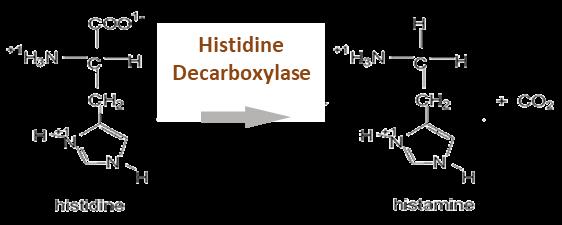
To avoid these consequences, it is important to maintain the freshness and quality of meat and meat products by avoiding microbiological growth, thus protecting materials as soon as possible from evisceration, transport, and processing. Biogenic amines are heat resistant and acid resistant molecules, which means, that once they are formed in the fresh crude raw materials they will survive and stay present in the final product produced with those raw materials. [iv],[v] In Figure 2 below you can see a graphic representing biogenic amine concentration (histamine, putrescine, cadaverine and tyramine) before and after autoclaving (elevated temperature and high-pressure process). As you can see the concentrations before and after are quite comparable.
Unfortunately, in the European Union there are still no maximum limits established for the concentration of biogenic amines in pet food. For the moment there is only legislation for histamine related to fish ingredients but only for humans.[ii],[iii]
Ideally, to control biogenic amine growth it is necessary to inhibit the microbial growth and the decarboxylase activity of microbes. These are some suggestions on how to do it:
Use cold storage
Frequent collection of raw materials and limitation of storage time during warm seasons
Process the materials as soon as possible
Good hygiene practice. Ensure that transport and processing equipment are kept sanitized to reduce microbial load
Use freshness treatments with the right organic acids combination able to: not affect palatability, not increase ash content, control a broad range of biogenic amines, not cause pro-oxidation
Parent Amino Acid Precursor Biogenic Amine
Histamine Histamine
Lysine Cadaverine
Arginine Putrecine/Agmatine
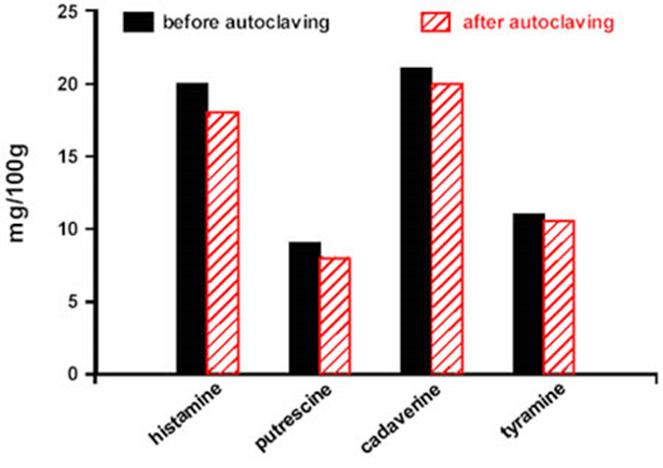
Tyrosine Tyramine
Other biogenic amines mentioned before like cadaverine and putrescine are known to have an impact on the palatability of finished pet food, but this topic will be discussed deeper in the next section of this article.
Free Fatty Acids
Another consequence associated with freshness decay is the increase of acidity or the formation of free fatty acids (FFA). In this case, the origin is the hydrolyzation of triglycerides by the action of the enzyme lipase. [vi] This process occurs in fresh raw materials containing fats and the formation of FFA increases systematically in the crude raw materials as the environment temperature rises. Once the crude raw materials are processed, to produce processed animal protein (PAP) and fat, the FFA level should not increase anymore over time.
Pet Food SuPPlement 2023 Page 29
Figure 1: Decarboxylation of the amino acid histidine to form the biogenic amine histamine
Table 1. Amino acid precursor and its corresponding biogenic amine.
Figure 2. Biogenic amines concentration before and after autoclaving. [iv],[v]
Usually, FFAs are used as an indicator of the freshness of a fat, oil, or PAP. The higher the FFA level, the less fresh the product is. Both parameters, FFA and biogenic amines are also indicators of the quality of the supply chain and give information about how the crude raw materials are handled. There is still a lack of knowledge regarding the potential negative effects of elevated levels of FFAs regarding the health of pets or the impact on the palatability and shelf life of finished pet food products.

Kemin is currently developing a set of trials to answer these questions, especially the one related to high FFAs and their impact on the palatability and shelf life of final pet food products. We hope to share the outcome of these trials soon.
To the best of our knowledge, there is, at the moment, no legislation related to maximum FFA levels allowed in pet food or pet food raw materials. What we have observed in the market is that pet food producers tend to require and set their own maximums limit towards their raw materials suppliers. This is often based on their own research/experience.
To control FFA formation, the same suggestions as for the control of biogenic amines mentioned before also apply here since both freshness parameters are caused by the same phenomenon, microbial growth.

From experience, we suggest treating as soon as possible sensitive raw materials inside the slaughterhouses with preservatives like ALLINSUR™ or RENTERRA™ Kemin product lines.
Factors Impacting Pet Food Palatability with a Focus on Biogenic amines
Loss of freshness can be initiated by microbial degradation in the pet food or in the initial crude raw materials used. It can cause two problems. Spoilage and decomposition of pet food, with consequential loss of organoleptic features and loss of nutrients, not only micronutrients, such as vitamins but also macro-nutrients, such as proteins and lipids. The decomposition process leads to the formation of some noxious substances, such as biogenic amines. The second potential consequence of microbial spoilage is food poisoning, from the growth of pathogenic microbes, such as Salmonella spp., Listeria monocytogenes, various Bacillus species, and many other bacteria.
Water activity plays a crucial role in the physical, chemical, and biological stability of foodstuffs. It is the ratio between the vapour pressure of water in a certain material and the vapour pressure of pure water, at the same temperature. In simpler terms, it is an index referred to in food that is used to express the availability of water free from bonds with other components and which can be used for chemical and biological reactions. The index is expressed as an absolute number between zero and one: the higher the value, the higher the availability of water for microbial growth and therefore the easier that spoilage can occur. Water activity is not to be confused with moisture content. Moisture is the total amount of free and bound water. The relationship between moisture and water activity depends on the specific material: there are specific molecules and substances, that can
Page 30 Pet Food SuPPlement 2023
Figure 3: Hydrolysis of triglycerides to form free fatty acids.
Figure 4. Water activity and microbial growth.[vii]
absorb or bind water and lower water activity, even if the moisture level is not affected. A water activity index below 0.6 is considered as safe because it allows no mould, yeast or bacterial growth, and enzymatic reactions are well restrained. So, the water activity index defines if a food is perishable or stable. That is why it is used as a key point of quality control programs.
When we refer to dry pet foods, we are speaking of foods that are typically stable thanks to their production processes, which involve heat treatment, and potentially the use of water-binding substances. The challenge to the pet food industry is to find the right combination of ingredients, processing, and packaging to create products that meet safety, quality, and cost parameters, and to satisfy consumers. Therefore, water activity could be used not only as a quality parameter but also as an active development tool.
It is possible to intervene against microbial development by lowering water activity as much as possible. In many cases, it is not possible to lower it below the safe value of 0.6, therefore it is essential to act in other ways, such as by using specific substances called preservatives. These kinds of additives intervene by altering the pH inside the microbial cell, interrupting its cellular functions to destroy the cell. Organic acids are widely used as preservatives. They are defined as weak acids because they release only part of their hydrogen atoms when put in a solution and depending on the pH of that solution, form a balance between the whole molecule and the ion forms (called dissociated forms). This process is called dissociation. So, weak acids can be found in undissociated form or at various levels of partial dissociation. Strong acids, on the contrary, release all hydrogen atoms and therefore are totally dissociated when in solution. The active form of the organic acid, which can penetrate the microbial cell, is the undissociated form. The lower the pH of the solution, the more undissociated the acid is, and therefore the more effective it will be. The pH at which organic acids are totally undissociated varies for each acid but is relatively low which, is unlikely to be suitable for a pet food matrix. Therefore, generally, the reference used instead is the pKa which is the pH at which the acid is fifty percent undissociated, which provides good efficacy as a preservative.
As already mentioned, microbes can cause food spoilage, with consequent loss of nutrients because molecules are altered and modified. This is precisely what happens when microbes alter the structure of amino acids, forming biogenic amines. That is why biogenic
amines are considered an index of freshness: the more biogenic amines, the lower the freshness of products.
Another important thing to highlight about biogenic amines is that they have a typical rotting smell, that humans can perceive when food decline is quite advanced. But animals, with an extremely developed sense of smell, can perceive biogenic amines at low concentrations and this can have an important influence on palatability. For all the reasons discussed above, it is especially important to have good control over microbial growth.
To assess the impact of biogenic amines on palatability, a study[viii] has been designed involving super premium commercial dry diets for dogs and cats, formulated for optimal palatability performance. The diets were bought at a pet store and tested for biogenic amine levels, with the intention of using the food only if it contained very low levels. The chosen products were then coated with a 2% water solution containing individual biogenic amines and two mixtures at different concentrations.
In both dog and cat foods, the first round of trial included the following trial samples:
Histamine alone (50 ppm) -
Putrescine alone (150 ppm) -
Cadaverine alone (250 ppm) -
Biogenic amines mix 1: sum of the previous amounts (450 ppm) -
For the second round of experimentation, it was decided not to increase the amount of histamine to protect the pets involved in the palatability trials, as 50 ppm is usually referred to as the maximum safe amount by scientific literature. So, the trial samples for both dog and cat diets were:
Putrescine alone (300 ppm) -
Cadaverine alone (500 ppm) -
Biogenic amines mix 2: sum of the previous amounts + histamine50 ppm (850ppm)
All samples were tested for biogenic amines after the experimental coating, to confirm the effectiveness of biogenic amine addition and the process. The samples were then all tested for palatability versus a control sample, consisting of the same diet coated with 2% water only, to balance its moisture level as it is a factor known to impact overall palatability.
As can be seen in Tables 2 and 3, all the first-round palatability trials did not show a statistically significant difference in performance. It is for this reason that the second evaluation step has been inserted in the study, doubling biogenic amines dosages (except histamine), as already indicated above.
Pet Food SuPPlement 2023 Page 31
TRIAL NUMBER TRIAL SAMPLE A: Super Premium adult dog food + BLANK SAMPLE B: Super Premium adult dog food + IR-A p-value FC-A (%) D1 50 ppm histamine (in 2% water) Water (2%) 0.49 0.4280 42.9 D2 150 ppm putrescine (in 2% water) Water (2%) 0.50 0.5750 46.3 D3 250 ppm cadaverine (in 2% water) Water (2%) 0.47 0.3070 46.8 D4 Mixture BA total 450 ppm (2%) Water (2%) 0.54 0.2280 55.7
Table 2. First round of palatability trials on dog kibbles coated with solutions of biogenic amines
D6 and D7 trials in Table 4 show a statistically significant preference for the control sample over the trial sample. The intake ratio (IR) of the A sample (the trial sample), is 0.27 with a low p-value. Also, the first choice (FC) of the A sample is low. These findings seem to suggest that the threshold of a dog’s sensitivity toward biogenic amine mix could be between 450 and 850 ppm. Furthermore, it seems quite clear from the outcome of the study that dogs have a specific sensitivity against some biogenic amines more than others. For example, at 400 ppm, cadaverine has been found to be enough to statistically decrease the palatability of the trial sample over the control. This might imply some biological defence mechanism of the animal, aimed at avoiding potentially harmful food.
Regarding the results of cat trials reported in Table 5, the outcome was not totally aligned with that of dogs. Mixed biogenic amines, even at the higher amount of 850 ppm, did not show any statistically significant effect on palatability performance. In the trials performed with the food spiked with individual biogenic amines, however, cats have been found to specifically dislike putrescine. In fact, 300 ppm was enough to considerably decrease palatability as two-thirds of cats preferred the control sample.
This study highlighted how biogenic amines can influence palatability. Their impact differs according to the target species, given that dogs and cats have shown specific sensitivities for distinct types of biogenic amines and at different amounts. However, it is fair to
acknowledge that, among various limitations of the study, the main one could be to the fact that biogenic amines were artificially added to otherwise completely healthy foods. This is a relevant factor, as the presence of biogenic amines was not linked with an actual degradation of the nutritional value or other organoleptic features of the food, and it was therefore not possible to assess whether this difference with the normal biological food spoilage could have had an impact on palatability preference of dogs and cats. In other words, is it only these 3 biogenic amines themselves affecting the palatability of food, or are the other biogenic amines in combination affecting it as well or not, or is it the other flavouring molecules related to decayed raw materials and the loss of nutritional factors also involved?
Ongoing Kemin Research on Freshness impact on palatability
For a better understanding of how freshness decreases palatability and especially how Kemin’s preservative solutions can assure healthy pets, the safety of pet food and ensure highly palatable pet foods, we are conducting this summer some specific study.
We will be exploring the PAP and Fat freshness impact on dogs’ and cats’ dry kibble palatability. This exclusive global study will be published in the coming months.
References Available on request from: tech-kne@kemin.com
Page 32 Pet Food SuPPlement 2023
TRIAL NUMBER TRIAL SAMPLE A: Super Premium adult cat food + BLANK SAMPLE B: Super Premium adult cat food + IR-A p-value FC-A (%) C1 50 ppm histamine (in 2% water) Water (2%) 0.50 0.4720 53.3 C2 150 ppm putrescine (in 2% water) Water (2%) 0.49 0.2300 48.6 C3 250 ppm cadaverine (in 2% water) Water (2%) 0.46 0.1560 52.7 C4 Mixture BA total 450 ppm (2%) Water (2%) 0.49 0.3610 51.4
Table 3. First round of palatability trials on cat kibbles coated with solutions of biogenic amines
TRIAL NUMBER TRIAL SAMPLE A: Super Premium adult dog food + BLANK SAMPLE B: Super Premium adult dog food + IR-A p-value FC-A (%) D5 300 ppm putrescine (in 2% water) Water (2%) 0.47 0.25800 49.4 D6 500 ppm cadaverine (in 2% water) Water (2%) 0.27 0.00141 30.0 D7 Mixture BA total 850 ppm (2%) Water (2%) 0.27 0.00065 27.8
Table 4. Second round of palatability trials on dog kibbles coated with solutions of biogenic amines
TRIAL NUMBER TRIAL SAMPLE A: Super Premium adult cat food + BLANK SAMPLE B: Super Premium adult cat food + IR-A p-value FC-A (%) C5 300 ppm putrescine (in 2% water) Water (2%) 0.35 0.00019 35.4 C6 500 ppm cadaverine (in 2% water) Water (2%) 0.54 0.22800 60.5 C7 Mixture BA total 850 ppm (2%) Water (2%) 0.50 0.46600 53.8
Table 5. Second round of palatability trials on cat kibbles coated with solutions of biogenic amines
Kimberly Nelson Named President of Kemin Nutrisurance
K emin Industries has named Kimberly Nelson, a third-generation member of Kemin’s founding family, as president of Kemin Nutrisurance, the company’s pet food and rendering technologies business unit.

Kemin was founded by Nelson’s grandparents, R.W. and Mary Nelson, 61 years ago. Nelson has been with Kemin for seven years, most recently serving as General Manager – North America for Kemin Nutrisurance. During her tenure, the global business unit saw double-digit sales growth despite the challenges of the COVID-19 pandemic and its stress on the supply chain.
“I’m thrilled to lead Kemin Nutrisurance and immensely proud to continue the important work my family has built over the last six decades,” said Nelson. “As a pet owner myself, I’m especially excited to be part of this business unit, and I am eager to continue our success and expand upon it to further cement our position as an industry leader.”
Prior to joining Kemin Nutrisurance, Nelson served as President
of Kemin Textile Auxiliaries, operating under the brand Garmon Chemicals. Nelson helped lead the acquisition of Garmon Chemicals in early 2018 and served as Business Development Manager, then General Manager – India, for Kemin Textile Auxiliaries.
“I am very pleased to promote Kimberly Nelson to President of Kemin Nutrisurance, as she has demonstrated the people-focused leadership and business savvy needed to guide our pet food and rendering business,” said David Raveyre, Worldwide Group President, Kemin Industries. “Kimberly has an excellent track record of driving innovation and has demonstrated her ability to effectively direct a global business unit. With the results she’s already delivered, I’m confident she will continue the impressive legacy of the Nelson family and Kemin.”
Nelson spent five years in marketing in Hong Kong before joining Kemin in 2017. She received her bachelor’s degree from Northwestern University and her master’s degree from Savannah College of Art and Design.
Nelson began her new role in October 2022, and Alberto Muñoz, currently Marketing Director for Kemin Nutrisurance, will fill her previous position as General Manager – North America for the business unit.
Kemin Names Dr. Jason Shelton as Global Vice President of R&D for Pet Food Group

K emin Industries recently added Dr. Jason Shelton to the Kemin Nutrisurance leadership team as Global Vice President of Research and Development for the company’s pet food and rendering technologies business unit.
In addition to overseeing the global R&D team for pet food and rendering technologies, Dr. Shelton will lead strategies that fuel Kemin Nutrisurance’s innovation pipeline and long-term growth.
“I’m thrilled to have Jason as part of our team and bring his years of experience in technology application, worldwide expansion and talent development to our pet food and rendering business,” said Kimberly Nelson, President, Kemin Nutrisurance. “With tenures in Europe, Asia and North America, Jason brings the global perspective and business savvy needed to grow our portfolio of products and services. His scientific background will further advance innovation in our R&D team and foster a solutionsoriented mindset.”
Prior to joining Kemin, Dr. Shelton spent more than 18 years
with Cargill, holding various leadership positions across multiple functions and geographies. Dr. Shelton served in R&D as Innovation Development Manager before taking on international appointments. He relocated first to Beijing as Regional Technology Director, then to Breda, Netherlands. Before returning to the U.S., Dr. Shelton was based in Moscow as Managing Director for Cargill’s Animal Nutrition and Health business unit in Russia. Most recently, Dr. Shelton was Cargill’s Chief of Party for USAID (United States Agency for International Development) TRANSFORM, a publicprivate partnership focused on improving human health through animal agriculture.
“I’m looking forward to being part of a company impacting so many aspects of our everyday life, and I’m excited to be entering the pet food industry,” said Dr. Shelton. “Kemin has a long history of scientific breakthroughs and a spirit of entrepreneurship that aligns with my career path, and I’m eager to merge these together to move Kemin Nutrisurance forward in the global marketplace.”
Dr. Shelton received his Ph.D. in animal science from Louisiana State University. Currently residing in Minnesota with his wife of 23 years and two teenage sons, Dr. Shelton will be based out of Kemin’s worldwide headquarters in Des Moines, Iowa, U.S.
Pet Food SuPPlement 2023 Page 33
Challenges and Trends in the Booming Pet Food Industry
With BESTMIX Software
Trends in the Pet Food Industry
The pet food industry has seen significant growth over the past few years, with a growing number of pet owners looking for high-quality and nutritious food options for their furry friends. As the demand for pet food continues to increase, manufacturers are faced with a number of challenges, including the need to keep up with changing consumer trends, meet evolving regulations, labour shortage and maintain a competitive edge in the market. Fortunately, software solutions can help address many of these challenges and provide pet food manufacturers with the tools they need to succeed.
A rise in demand for premium and natural pet food products


One of the biggest trends in the pet food industry is the increasing demand for premium and natural pet food products. According to a report by Grand View Research, the global natural pet food market is expected to reach $28.5 billion by 2027, with a compound annual growth rate (CAGR) of 6.7%. This trend is driven by consumers’ desire to provide their pets with high-quality, minimally processed, and healthy food options. However, meeting this demand can be challenging for pet food manufacturers, who need to source high-quality ingredients, develop new formulations, and ensure product safety and consistency.
including ingredient analysis, nutrient profiling, and cost optimisation. This allows manufacturers to develop new products quickly and efficiently while ensuring that they meet the nutritional requirements of different pets.
Product safety and regulation compliance
Another key challenge for the pet food industry is maintaining product safety and compliance with regulations. According to a report by Persistence Market Research, the global pet food safety testing market is expected to reach $2.5 billion by 2026, with a CAGR of 6.3%. This reflects the growing importance of ensuring that pet food products are safe, free from contaminants, and comply with relevant regulations. BESTMIX offers a range of features that can help pet food manufacturers maintain product safety and compliance, including ingredient traceability, batch tracking, and quality control. This allows manufacturers to identify and address potential issues quickly, ensuring that their products meet regulatory requirements and are safe for pets to consume.
Labour shortage
Software solutions can help pet food manufacturers tackle these challenges by providing them with a platform to manage their product development, quality control, and regulatory compliance processes. For example, the BESTMIX software solution offers a range of tools for formulating and optimising pet food recipes,
Labour shortage is another challenge the pet food industry is facing, which has been exacerbated by the COVID-19 pandemic. The pet food manufacturing process often requires a significant amount of manual labour, from ingredient preparation to packaging and distribution. With a shortage of available workers, pet food manufacturers may struggle to meet production demands, leading to delays and reduced output.
Software solutions can help pet food manufacturers address this challenge by automating many of their processes and reducing
Page 34 Pet Food SuPPlement 2023
the need for manual labour. For example, BESTMIX formulation and optimisation tools can help manufacturers develop recipes more quickly and efficiently, reducing the time and labour required for this process. Additionally, BESTMIX batch tracking and quality control features can help manufacturers identify and address issues more quickly, reducing the need for manual inspections and quality checks.
By leveraging software solutions pet food manufacturers can improve their efficiency and productivity, even in the face of a labour shortage. This can help them maintain their production levels and meet the growing demand for high-quality pet food products.

In addition to addressing these specific challenges, software solutions also provides pet food manufacturers with a range of other benefits, including increased efficiency, better collaboration, and improved data management. By streamlining their processes and providing real-time access to data, software solutions can help pet food manufacturers make better-informed decisions, reduce waste, and improve their overall profitability.
Conclusion
Overall, the pet food industry is facing several challenges, including meeting evolving consumer demands, maintaining regulatory compliance, and staying competitive in a crowded market. However, by leveraging software solutions, pet food manufacturers can address these challenges and position themselves for success in the years ahead.
With over 40 years of experience in the industry, BESTMIX has developed a deep understanding of the challenges and opportunities facing pet food manufacturers. Its software solution is designed specifically for the pet food industry, with a range of features and tools tailored to the unique needs of pet food manufacturers. In addition, BESTMIX offers exceptional customer support and training, ensuring that its customers can make the most of its software solution and achieve their business goals.
Supercharge your business growth with:

BESTMIX • ® Recipe Management – streamlines production and formulation processes, tracks and optimises rations, provides batch tracking and scheduling, and offers analysis and reporting tools to improve production efficiency and cost reduction.
BESTMIX • ® Quality Control - links production processes with quality control measurements with focus on the specific needs of nutrition industries
BESTMIX • ® SpecTrack - centralises data of your suppliers on one single web platform
BESTMIX • ® ERP Suite - solution for the nutrition industry powered by and certified for Microsoft Dynamics 365 for Finance and Operations
Each of these solutions provides unique combination of expert knowledge, long-time experience and modern technologies.

Find


Get tips on how to keep a grip on information from and about your suppliers.

Learn how to automate the collection and interpretation of quality data.

Pet Food SuPPlement 2023 Page 35 Scan the QR-code and register now! Join our live webinar | 25 May – 11:00 AM (CST) Quality Assurance in the Pet Food Industry: Turn Challenges into Discover how software can help you take an integrated approach to quality assurance. Learn how to deal with labor shortages, unreliable supply chains, and the growing demand for transparency.
out
quality assurance
how to turn
from cost to revenue.
BESTMIX® software is the perfect solution for petfood producers and developers
to streamline their operations and www.bestmix.com
seeking
A Proactive, Customised Approach to Pet Care
By James Kyffin, BVSc MRCVS, Commercial Director – Pet Nutrition EMEA, ADM Protexin
Pet populations are rising around the world, with an estimated total of 540 million dogs and 460 million cats by 20261. At the same time, people’s relationships with their pets are deepening, and modern pet parents increasingly believe that their companion’s wellness needs mirror their own. That means today’s consumers are taking a more proactive approach to their overall well-being and that of their pets.

Notably, over 40% of global pet parents say they turn to various nutrition products to support their pet’s wellness 2. Most seek out tailored solutions to fit their individual pet’s preferences, as well as physical and behavioural health requirements. For instance, support for immune function is seen as a lifelong need, while products customised for joint health or kidney support can enhance care for aging pets. The top concerns that pet parents would like pet health supplements to support include stress and calming, mobility and joints, immune function, skin and coat, liver and kidney, and digestion1 Furthermore, many consumers scan labels for claims like “clinically tested,” “scientifically studied” and “vet recommended” as evidence of a product’s effectiveness3. Another source of reassurance for consumers of product efficacy is the use of branded health ingredients, which are more likely to be supported by clinical evidence. Indeed, over 60% of global pet owners say branded health ingredients in pet products are important2
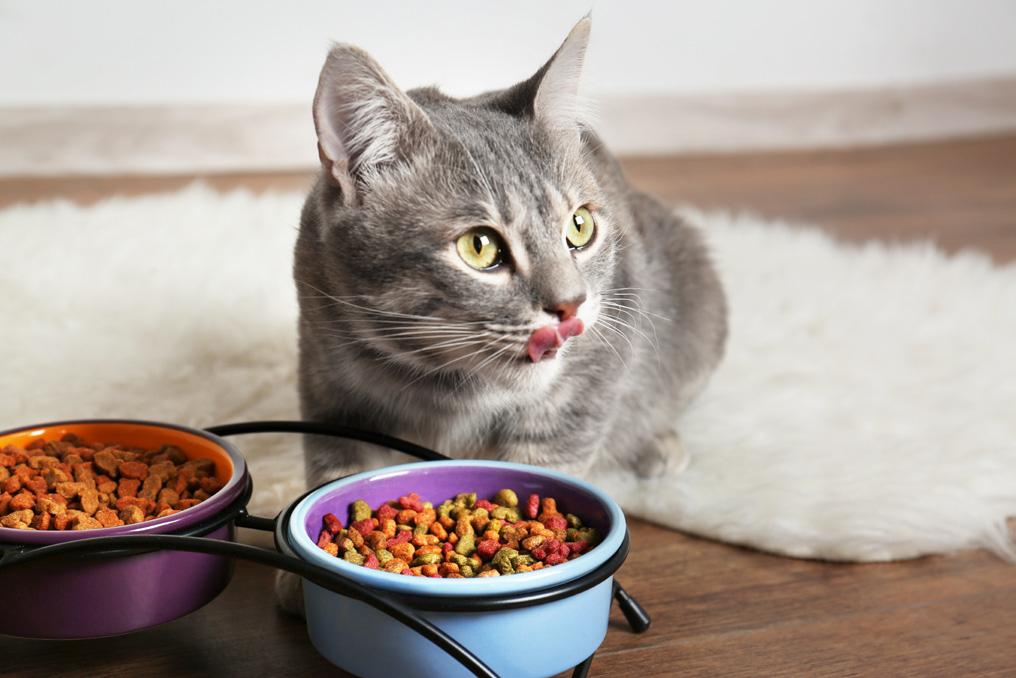
Enzymes, with facilities in the U.S. and Denmark, brings new health and wellness solutions to ADM’s expansive capabilities. Plus, the 2023 opening of a new production facility in Valencia, Spain will help meet rising global demand for microbiome-supporting solutions. This new facility is located near ADM’s pioneering Microbiome Research Center in the University of Valencia Scientific Park. Current projects are exploring the potential of postbiotic strains to support oral health and improve pet’s resilience to stress.
Scientific breakthroughs are paving the way for proactive solutions that can support pets’ brains and bodies at all life stages. Globally, ADM has 59 innovation centres with hundreds of scientists, technicians and employees dedicated to human and animal nutrition research and development. For example, ADM Protexin, based in Somerset, U.K., specialises in probiotics, from production to marketing and sales services. A recent acquisition of Deerland Probiotics &
ADM also has numerous relationships with research institutions around the world, which helps propel innovation and product development. For example, a project in partnership with the University of Illinois is investigating the potential for a botanical extract to help regulate glycaemia, which may support weight management. Globally, 60% of pet owners are concerned about the weight of their animal, and 72% of those are taking action to correct this issue 2. Additionally, ADM research with UNESP Brazil has uncovered nutrition that may support cognitive function in pets.
With more products for balanced health and wellness to choose from, pet parents can select the offerings best suited to address their dog’s or cat’s specific needs while fostering development and healthy aging. This includes foods and treats made with ingredients that offer nutritional benefits and non-nutritive supplements that support structures and functions of the body. Pet products are typically formulated for one specific issue, such as oral care or digestive health. Recently, brands have started introducing products to address multiple concerns or general wellness, much like the multivitamin supplements for humans that are gaining market share.
Another way pet parents are customising care is with pampering products. Many pets are treated to frequent moments of small indulgence. In fact, 70% of global pet owners say it’s ok for their dog
Page 36 Pet Food SuPPlement 2023
or cat to enjoy an indulgent food-based treat as part of an overall healthy diet2. Retail shops are full of food toppers, mix-ins and culinaryinspired offerings tailored to dog and cat preferences that will also appeal to their humans. Variety can enhance sensory appeal and provide positive experiences for pets, which means playful products in eye-catching colours, exciting flavours and interesting shapes are particularly on-trend.
From soft chews to dental sticks and squeezable pastes to powders, advanced manufacturing technologies are enabling a plethora of product formats. Understanding palatability is key for product developers, given that 85% of owners monitor whether their pets like the taste of the products that they purchase2. Plus, 65% of global pet parents like to see products with new and unusual flavours for their dogs and cats2. This aligns to the human trend of 74% of global consumers who say they like food and drink products with experimental flavors4; however, pet owners are more focused on premium meaty and vegetable flavours that they associate with high levels of sensory appeal rather than exotic flavours in pet products. Custom blends of pet-friendly flavours sourced from nature can achieve an array of taste profiles tailored to the application, like a tin of beef au jus or baked pumpkin spice biscuits.
It’s clear that the humanisation of pets has become more than a trend – it’s now mainstream and gaining traction around the world. More and more, pet parents are taking a comprehensive approach
to their companion’s well-being, including proactive care for weight management, digestive health and immune function. Brands that keep the latest scientific developments and consumer insights in mind when developing new pet products will be well-positioned to succeed in this competitive global marketplace.
References
1Euromonitor International, 2021
2FMCG Gurus, Pet Care Health, 2022
3Mintel, US Pet Owners Survey, 2021
4FMCG Gurus, Flavor, Color & Texture Trends, 2021
James Kyffin is the commercial director for ADM pet nutrition in EMEA and is also the global lead for ADM Protexin’s pet supplement business. He is a qualified veterinary surgeon, having qualified from the University of Bristol in 2005. After five years working in small animal clinical practice in the UK, he joined ADM Protexin and has filled a variety of roles within the business over the last 13 years.

ADM Invests in Pet Premix Production Line in Château-Thierry
ADM announced the opening of a new premix production line at its pet nutrition facility in Chierry, France. The state-of-the-art line will concentrate on premium and functional pet premixes, which can be used in the production of dry and wet pet food, treats, and dietary solutions– greatly expanding ADM’s pet nutrition capabilities.
“Consumers increasingly turn to food and treats as a source of overall health and wellbeing for their pets. We’re excited to continue investing in the pet nutrition space to help our customers meet these growing demands for high-quality, responsibly produced pet nutrition products,” said ADM pet nutrition president, Jorge Martinez. “Our new pet premix capabilities allow us to explore new ways of blending specific ingredients, opening up incredible potential for innovation that helps position ADM as a go-to partner.”
ADM celebrated the opening with a two-day event in ChâteauThierry (Champagne region, France) gathering many customers from October 18-19, 2022, including presentations on the pet food market, healthy pet treat innovations, biotics in pet applications, and new premix line opportunities. A ribbon-cutting ceremony and a tour of the expanded production plant will also occur.
“More than ever, ADM’S expansive portfolio of top-quality ingredients allows customers to eliminate the complexity of sourcing
ingredients and qualifying suppliers,” stated Martinez, “ADM is the strategic partner for developing on-trend pet food and treat innovations for today’s pet owner’s demands while ensuring unsurpassed safety and quality.”
This investment is the latest to advance ADM’s footprint in the pet nutrition space. Last year, the company announced its acquisition of majority stake in PetDine, Pedigree Ovens, The Pound Bakery and NutraDine (P4 Companies). The acquisition significantly expanded ADM’s pet treat and supplement capabilities to further meet global demand for high-quality, nutritious pet solutions. The P4 investment is similar to ADM’s 2017 acquisition of Crosswind Industries, a manufacturer of contract and private label pet treats and foods and provider of specialty ingredients. More recent enhancements to ADM’s pet nutrition capabilities include new and upgraded facilities in the U.S. and globally, including a pet food culinary kitchen and pilot extrusion line at the Animal Nutrition Technology Center in Decatur, Illinois. The facility builds upon ADM’s legacy of innovation in Animal Nutrition, offering capabilities to enhance customer collaboration and develop fully tailored nutrition solutions. The centre is also equipped with a laboratory that enables pilot-scale capabilities and allows for testing of new product development prior to full-scale production
Pet Food SuPPlement 2023 Page 37
Natural and cost-effective antioxidants solutions
Innovative systems to protect the new sources of animal proteins
By Yohann Hureau, Global Business Unit Manager, Vitablend

Change is around the corner
A concern for naturalness in human foods has extended to a greater awareness about additives in pet food. This has been accompanied by a slow but steady increase in the re-evaluation of the safety of synthetic antioxidants in pet food. This re-evaluation has extended to the antioxidants butylated hydroxyanisole (BHA) and butylated hydroxytoluene (BHT). The most recent concerns have been expressed over BHA and, in particular, its re-authorization for use in cat food.

Synergies of natural options
During the last 20 years, Vitablend’s technical team has worked and developed synergistic solutions using natural and traditional active compounds to provide meals, fats, oils to petfood producers offering them the best cost in use solutions. This approach helps us in developing natural systems that offer similar performance to traditional synthetic antioxidants.
The combination of tocopherols and rosemary extract is showing excellent performance in various types of animal proteins and fats. Mixed tocopherols, vitamin E itself and Rosemary Extract (botanical extract) are commonly used in the industry. Our large Toco-PET range can be used to protect the many types of meals and fat used by the industry.
What’s next…. new sources of proteins
Our alternatives
The transition from synthetics (BHA and BHT) to natural additives might reveal that naturalness comes with a challenge – in terms of both cost and the stability of the pet food. Therefore, more attention should be paid to the synergy between naturals and ‘more acceptable’ synthetics used in food systems with proven long-standing safety, such as infant nutrition. Ascorbates, gallates and chelates all work well with natural antioxidants and are cost-effective. The drivers of these compounds work together and are suitable for use in the pet food process. Pet-Safe (which does not contain BHA/BHT) offers a great alternative to standard synthetic antioxidants with a very competitive cost in use. This provides a very interesting opportunity for those looking for a transition between the synthetic and fully natural solutions.
To sustain the increasing demand, the industry is now looking at new sources of animal proteins. Vitablend has done extensive research to find the best alternatives to protect insect meals and fat. This type of matrix can contain up to 45% fat which contains polyunsaturated fatty acids very sensitive to oxidation. In our recent studies we have tested various antioxidants systems. Antioxidant capacity was measured by the induction point (hrs) to oxidation under accelerated conditions. The study showed that our Toco-PET TR 10 L (Tocopherols and Rosemary Extract) provides a similar level of protection as a traditional BHA/BHT synthetic system, enhancing the shelf life up to 50%. Our Toco-PET TR 10 L is one example of a very versatile system which can be used to protect multiple type of meals and oils.
Vitablend is a manufacturer of antioxidant and nutritional systems. Part of the Barentz Group, it has its HQ in Holland, factories in Holland, USA and Singapore.
Page 38 Pet Food SuPPlement 2023
PARTNERSHIP OF PET CHARITIES WORKING WITH PET FOOD COMPANIES TO HELP PEOPLE STRUGGLING TO FEED THEIR PETS
A n alliance of national animal charities has joined forces with FareShare and global corporate donors including Pets at Home, Petplan, Purina Petcare, Lily’s Kitchen, and Mars Petcare to help owners in need to feed their hungry pets in the face of the cost of living crisis.
Dogs Trust, RSPCA, Battersea, and Cats Protection are working together with industry body UK Pet Food to secure food from pet food manufacturers, which is then distributed all over the UK through FareShare, the UK’s largest charity fighting hunger and food waste.

This initiative has been made possible thanks to Petplan, the UK’s no.1 pet insurer, covering the cost of distributing food to pets in need.
The alliance will help redistribute pet food to FareShare’s network of 9,500 charities which, as well as providing food banks, also provide wraparound services that help tackle the root causes of poverty, including homelessness shelters, women’s refuge centres, older people’s lunch clubs and after school clubs. This pet food will help owners most impacted by the cost of living crisis.
To date, the programme has received 43,621 kilograms of pet food, the equivalent of over 304,000 meals for hungry pets across the UK, who might not otherwise have been fed a proper meal that day.
Always a better solution
Petplan has generously donated £100,000 towards the
• costs of distribution of the food through FareShare’s national network
• dog meals
Pets at Home has generously donated 38,267 Wainwright’s
Lily’s Kitchen has generously donated 332 dog meals and has
• committed to making sizeable monthly donations from May Mars Petcare has generously provided 42 pallets of dog and
• cat food to create thousands of meals
Purina Petcare has committed to donating 2 pallets of dog
• and cat food every month, on top of an initial donation of two pallets
Other UK Pet Food members contributing to the cause include:
• Burgess Pet Care, Fold Hill, Butcher’s Pet Care and Edgard & Cooper.
Owen Sharp, CEO of Dogs Trust commented: “It’s a privilege to be able to join forces with our fellow charities and work hand-in-glove with the corporate sector to make sure our cherished family pets don’t have to go hungry. Dogs Trust continues to receive record-breaking numbers of calls from people who need to give up their pets, so huge thanks to everyone involved in this much-needed project.”
Nicole Paley, Deputy CEO of UK Pet Food added: “Our members are responsible for feeding 90% of the nation’s pets, so we have been delighted that many have signed up to the scheme and donated pet food for those in need.”
Barentz Animal Nutrition is a global distributor of technical and nutritional ingredients for the pet food industry. We have several solutions for clean label, hypoallergenic, sustainable, vegetarian and organic concepts. We are your one-stop-shop. www.barentz.com/animal-nutrition
Hydrocolloids
… PET SUBJECTS … PET SUBJECTS… PET SUBJECTS … PET SUBJECTS …
Plant-based proteins
Antioxidants Colors
M ARS P ETCARE C OMPLETES A C q UISITION OF CHAMPION PETFOODS
Mars Petcare has announced that it has completed its acquisition of Champion Petfoods. Champion Petfoods is a key player in the fastgrowing premium pet food space and its two premier brands, ORIJEN and ACANA, are trusted by pet parents around the world.
The company state that Champion Petfoods is a great addition to Mars Petcare, complementing its global portfolio across pet nutrition products and health services. (Champion Petfoods will operate as an independent business unit within Mars Pet Nutrition.)
Ikdeep Singh, Global President, Mars Pet Nutrition, stated: “We are excited to officially welcome Champion Petfoods into the Mars Petcare family of businesses. We’re looking forward to working with the talented Champion Petfoods team, supporting their continued growth journey, and advancing our Purpose to create A Better World For Pets™.”
BIOIBERICA LAUNCHES FIRST- OF-ITS -KIND ATOPIVET® COLLAR SKIN HEALTH SOLUTION FOR DOGS AND CATS
Bioiberica has announced the launch of its latest innovation, the Atopivet® Collar – a skin health solution for the companion animal health market. It offers pet owners an alternative to traditional topical and oral treatments with a more convenient application format to support with the management of atopic dermatitis – a chronic skin condition, which affects at least 10% of dogs. Following a successful launch in the US last summer, the Atopivet® Collar is now available in Spain, with plans to launch across Europe in the near future too.
The collar functions by releasing Bioiberica’s biologically-derived skin health ingredients directly onto the pet’s skin, which are then spread across the body through the lipids of the skin. One of these ingredients is Biosfeen®, which has been shown to boost filaggrin expression, in turn helping to maintain the integrity of the skin barrier in both in-vitro and in-vivo trials.
“Thanks to its dual maintenance and sparring effect, the Atopivet ® Collar is well equipped to aid in the cyclical nature of atopic dermatitis and help reduce flare-ups,” explains Sergi Segarra, R&D Project Manager, Animal Health at Bioiberica. “While the collar usually takes one-to-two months to have an effect, we’ve already received really positive feedback since launching the product in the US last year and now we’re excited to bring the Atopivet® Collar to Europe and beyond.”
Atopic dermatitis can start as early as six months old for some animals, with symptoms including itchy, inflamed and damaged skin, as well as scaly patches and fur loss. The life-long condition is characterised by short-term flare-ups – particularly in the spring and summer months –which can be difficult for pet owners to manage. Existing support for atopic dermatitis, such as topical and oral treatments, can be problematic and time-consuming for pet owners to administer. The new Atopivet® Collar provides an additional tool to address these challenges with an easy, fuss-free collar application. In addition, the collar is lavender-scented, waterproof and available in two different sizes to suit a variety of pets.
“We recognised the need for an accessible, effective option that gives owners the freedom to choose a non-invasive, practical alternative to traditional oils, creams and tablets,” comments Jordi Flores Garcia, Marketing Director, Companion Animal Health at Bioiberica. “While the collar format is a completely new and innovative approach to supporting pets’ skin health, the ingredients within it have already been shown to be an effective aid for skin conditions like atopic dermatitis, giving vets and pet owners alike assurance of its results.”
LALLEMAND ANIMAL NUTRITION LAUNCHES PETWAG: A N INNOVATIVE PET WELL - BEING ASSESSMENT GUIDE
Lallemand are pleased to announce the launch of a unique tool to help veterinarians and pet owners assess dogs’ well-being: PetWAG. It is a four-step guide to measure and monitor dogs’ welfare based on personality and mood state. Additionally, it provides practical tips and nutritional solutions that will help support and improve the pet’s emotional well-being.
The PetWAG tool was developed in partnership with pet expert Dr. Robert Falconer-Taylor, who was the Veterinary Director and Head of Education at the Centre of Applied Pet Ethology in the UK.
He explains: “In pets, as in humans, we must differentiate emotional state from mood state. Mood state is an average of all emotional states over a period of time. As a behaviourist, I consider animal body language as a window into emotions and mood states. Then, the animals’ personality is another important element to consider as it affects how he will react. PetWAG brings together pet emotion, mood states, body language and personality into one, easy-to-use tool.”
M I A LGAE LAUNCH OMEGA -3 PRODUCT , NATURALGAE
MiAlgae has officially launched its omega-3 product NaturAlgae to market thanks to recent expansion of its commercial production site in Scotland.
MiAlgae recycles the co-products from the Scotch Whisky industry, like pot ale, as a feedstock to grow omega-3 rich microalgae which can then be used as a nutritious fish feed and pet food ingredient.
The company’s manufacturing process aims to reduce global reliance on billions of wild-caught fish, the traditional source of omega-3.
Following the installation of eight new bioreactors north of Glasgow, MiAlgae will soon be producing 100’s of tonnes of nutrient-rich omega-3 powder per year.
NaturAlgae is a dry powder with a high concentration of DHA and other oils This powder can easily be added to recipes for pet food and aquafeeds, providing the well-known health benefits that omega-3 provides.
With final commissioning underway, the vessels will enable MiAlgae to boost production capacity almost immediately with a growing waiting list of customers.
Page 40 Pet Food SuPPlement 2023 … PET SUBJECTS … PET SUBJECTS… PET SUBJECTS … PET SUBJECTS …

biochem.net E.C.O.Trace® E.C.O.Trace® Contact us: · +44 7722 019727 Organically Bound Trace Minerals. Small Input - Great Effect.
Global leader in pet premix
World-beating food safety and peace of mind for your brand.
Operating from our ISO22000:2005 accredited premix plant, Trouw Nutrition is acknowledged worldwide as the industry’s gold standard leader. Our unrivalled knowledge and expertise, supported by our unique Nutrace® food safety and traceability system, make us your only choice of expert partner in developing and delivering nutritional solutions tailored to your specific requirements.
Visit our NEW website: trouwnutritionpets.com/en-gb
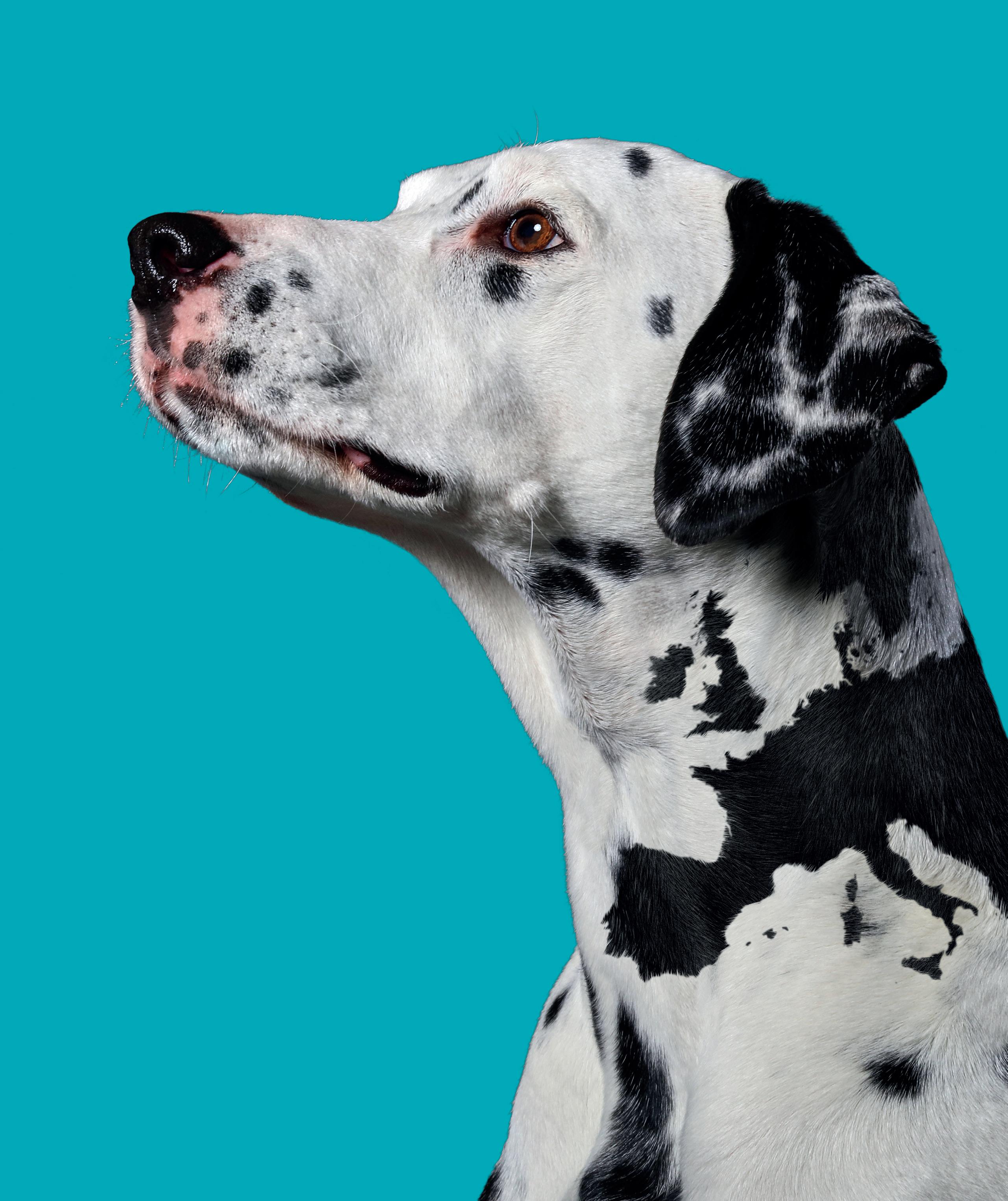
















 By Mim Figueiredo, International Business Development Europe at Tmall Global, Alibaba Group
By Mim Figueiredo, International Business Development Europe at Tmall Global, Alibaba Group





 By Sarah-Jane Godfrey, Pet Technical Manager, Trouw Nutrition GB
By Sarah-Jane Godfrey, Pet Technical Manager, Trouw Nutrition GB
























































